#unit 8 system analysis and design assignment
Explore tagged Tumblr posts
Text
Playtesting and Pitching Insights
Upon finishing all three prototypes and Assignment 3, I think it safe to say I understand the significance of playtesting (specifically early playtesting) and the skill and usefulness of pitching. In the reading ‘Game Design Workshop: A playcentric approach to creating innovative games’ by Tracy Fullerton, she discusses both playtesting and pitching. Pitching is a skill requiring cohesiveness and conciseness, make the game easy to understand, to the point people with even no experience can follow, like recipe but with the engagement capacity of their favourite show. The pitching we used in this unit was an elevator pitch, one page and one sheet, these are useful and simple ways to convey the details, premise, and concepts of your game without thorough development or planning as they are generally created at the start of the development process. Tracy lists 8 types of pitching materials that are sought after and significant to pitching your game, these are:
Sell Sheet (This is a “short attention span” document that explains your idea as well as the target market. The sell sheet should include: game title, genre, number of players, platform, ship date, two-paragraph description, bullet point list of features, and some game art
Pitch deck (This is the heart of your presentation. It will include a top-level description of your game, key art, trailer or gameplay demo, unique features and selling points and player experience, target audience, comparable games, budget, milestones, and team information.)
Game Demo (Demos can be built in differing degrees of completeness. The important thing is that the publisher can get to evaluate the final gameplay)
Gameplay video or trailer (If you cannot produce a standalone playable demo, then a gameplay video is the next best thing. It is a video file that shows the characters and gameplay. The most credible video will be one created using your game code)
Concept document (This is a brief game design document written without excessive details. Ideal contents include: game story, game mechanics, level design outline, controls, interfaces, art style, music style, feature list, preliminary milestone schedule, and a list of team members with short bios)
Gameplay storyboards (This is concept art that tries to capture the essence of your game. These can be in sketch form or final art or both. Ideal key art includes: character concepts, gameplay in action, and key locations)
Technical design overview (This is a technical design document without excessive details. Ideal contents are: general overview, engine description, tools description, hardware used (development and target), history of code base, and middleware used, if any)
Competitive analysis (This identifies titles you are competing against. It shows that you understand the market and your relative position within it. Ideal contents are: summary of your concept’s market position and reason for success and pro and con descriptions of competitive titles with sales figures, if you can get them)
Fullerton, Tracy. Game Design Workshop : A Playcentric Approach to Creating Innovative Games, CRC Press LLC, 2024 (Chapter 16)
These are all materials she states are vital to setting yourself up for the most successful outcome but are not direct keys to being your pitch being chosen for publishing.
Another aspect that Tracy emphasises on is that prototyping and playtesting should be done as early as possible, and to constantly playtest, evaluate and then iterate on the game until its launch. I have learnt firsthand throughout this unit that it is vital to have this kind of system as it will undoubtedly fix initial miscommunication and gameplay faults. The process we used in this unit follows what Tracy outlines very well: Introduction (Script), Warm-up (Questionnaire), Play session, Discussion of gameplay experience (Survey), Wrap-up. This was the outline for all playtesting in Assignment 3. On a similar note the level or feedback also follows an outline: self-testing (done by yourself and those working on the game), confidants (people you know), strangers, target audience. This outline will really help to determine if the game is turning out as you want or if you’ve completely missed the mark, we had this problem in A3 because we did research into other racing games as opposed games with similar gameplay or core mechanics and having this road of playtesting would help us determine this as early as possible.
It is also very important to take notes during the playtesting and even record the experience (if possible) to rewatch later in case you missed anything during the initial test. Having multiple people taking notes on different aspects also helps you not miss vital points in the test when recording their comments or an event that occurred. Tracy outlined an incredibly useful sheet on pages 379-381 for things the playtest conductor should fill out during and after the test takes place to get the most out of the experience as possible. On another note, it is important for the playtest conductor to remember not to lead the tester to specific answers or solutions and to encourage them to think out loud in order to get the most naïve and pure perspective about your game.
Fullerton, Tracy. Game Design Workshop : A Playcentric Approach to Creating Innovative Games, CRC Press LLC, 2024 (Chapter 9)
Overall, playtesting is vital to all game development and design, while pitching is important when trying to secure publishing, advertising, marketing or investment and is even useful when briefing team members. That’s all for the insights I have learned from the reading and throughout this unit.
That’s all for this post, I am unsure what the next post will be but I’ll see you there :D
0 notes
Text
Revit Interview Questions and Expert Answers: The Ultimate Guide for 2025
If you’re preparing for a Revit interview—whether as a fresher, architect, BIM professional, or structural engineer—having a solid grasp of common questions and their best answers can set you apart. Revit, a powerful Building Information Modeling (BIM) software by Autodesk, is widely used across the architecture, engineering, and construction (AEC) industries.
This guide covers the most frequently asked Revit interview questions, categorized by experience level and role.
Basic Revit Interview Questions (For Beginners)
1. What is Revit? Answer: Revit is a BIM software developed by Autodesk for architects, structural engineers, MEP engineers, designers, and contractors. It enables users to design a building and structure and its components in 3D, annotate the model with 2D drafting elements, and access building information from the model’s database.
2. What are the key differences between CAD and Revit? Answer:
CAD is primarily 2D drawing-based.
Revit is 3D and BIM-focused.
CAD focuses on drawing lines and shapes, while Revit works with real-world elements like walls, windows, and doors.
Revit allows for data-driven workflows, which CAD does not.
3. What are families in Revit? Answer: Families are components used to build a model in Revit. They can be system families (walls, floors), loadable families (furniture, fixtures), or in-place families (custom components made for specific projects).
4. Explain the term 'Workset' in Revit. Answer: Worksets are a way to divide a Revit project into manageable pieces, especially for team collaboration. Each user can check out a workset and work on it independently.
Intermediate Revit Interview Questions
5. What is the difference between Instance and Type parameters? Answer:
Instance parameters affect a single component only.
Type parameters affect all components of that type in the project.
6. How do you manage collaboration in Revit? Answer: Through Revit Worksharing and tools like BIM 360, multiple users can work on the same project simultaneously. Worksets and syncing help coordinate changes.
7. How do you create a custom family in Revit? Answer:
Go to File > New > Family.
Choose an appropriate family template.
Model the geometry using tools in the Family Editor.
Define parameters and save/load the family into your project.
Advanced Revit Interview Questions
8. What is the purpose of View Templates in Revit? Answer: View templates standardize the appearance and visibility settings of views. They ensure consistency across multiple views and save time during documentation.
9. How does Revit handle phasing? Answer: Phasing allows users to manage construction stages (existing, demolition, new construction). Each element can be assigned to a specific phase, which is reflected in schedules and views.
10. What is the difference between linked and imported CAD files in Revit? Answer:
Linked CAD files are referenced into Revit and updated when the source changes.
Imported files are embedded directly and do not reflect source file changes.
Role-Specific Questions
For Architects: Q: How do you manage design options in Revit? Answer: Revit allows the use of design options to explore multiple design solutions within the same project. This is useful for client presentations and internal reviews.
For Structural Engineers: Q: How do you use Revit for structural analysis? Answer: Revit Structure can be used in conjunction with analysis tools like Robot Structural Analysis. Structural elements can be exported with analytical data for simulation.
For MEP Engineers: Q: What are systems in Revit MEP? Answer: Systems define logical connections between MEP components. For example, a duct system connects diffusers, ducts, and air handling units in one network.
Tips for Revit Interviews
Be prepared to demonstrate your skills live, often through a short modeling task.
Showcase your knowledge of BIM workflows, not just Revit as software.
Highlight any experience with collaboration tools like Autodesk BIM 360 or Navisworks.
Mention real-world projects you've contributed to.
Conclusion
Revit is more than just modeling—it's about smart collaboration, data management, and precision in design. Whether you're a beginner or an experienced user, being prepared for both technical and conceptual questions will help you succeed in any Revit interview.
1 note
·
View note
Text
Assignment 4:
K-means Cluster Analysis in the banking system
Introduction:
A personal equity plan (PEP) was an investment plan introduced in the United Kingdom that encouraged people over the age of 18 to invest in British companies. Participants could invest in shares, authorized unit trusts, or investment trusts and receive both income and capital gains free of tax. The PEP was designed to encourage investment by individuals. Banks engage in data analysis related to Personal Equity Plans (PEPs) for various reasons. They use it to assess the risk associated with these investment plans. By examining historical performance, market trends, and individual investor behavior, banks can make informed decisions about offering PEPs to their clients.
In general, banks analyze PEP-related data to make informed investment decisions, comply with regulations, and tailor their offerings to customer needs. The goal is to provide equitable opportunities for investors while managing risks effectively.
SAS Code
proc import out=mylib.mydata datafile='/home/u63879373/bank1.csv' dbms=CSV replace;
proc print data=mylib.mydata;
run;
/********************************************************************
DATA MANAGEMENT
*********************************************************************/
data new_clust; set mylib.mydata;
* create a unique identifier to merge cluster assignment variable with
the main data set;
idnum=_n_;
keep idnum age sex region income married children car save_act current_act mortgage pep;
* delete observations with missing data;
if cmiss(of _all_) then delete;
run;
ods graphics on;
* Split data randomly into test and training data;
proc surveyselect data=new_clust out=traintest seed = 123
samprate=0.7 method=srs outall;
run;
data clus_train;
set traintest;
if selected=1;
run;
data clus_test;
set traintest;
if selected=0;
run;
* standardize the clustering variables to have a mean of 0 and standard deviation of 1;
proc standard data=clus_train out=clustvar mean=0 std=1;
var age sex region income married children car save_act current_act mortgage;
run;
%macro kmean(K);
proc fastclus data=clustvar out=outdata&K. outstat=cluststat&K. maxclusters= &K. maxiter=300;
var age sex region income married children car save_act current_act mortgage;
run;
%mend;
%kmean(1);
%kmean(2);
%kmean(3);
%kmean(4);
%kmean(5);
%kmean(6);
%kmean(7);
%kmean(8);
%kmean(9);
* extract r-square values from each cluster solution and then merge them to plot elbow curve;
data clus1;
set cluststat1;
nclust=1;
if _type_='RSQ';
keep nclust over_all;
run;
data clus2;
set cluststat2;
nclust=2;
if _type_='RSQ';
keep nclust over_all;
run;
data clus3;
set cluststat3;
nclust=3;
if _type_='RSQ';
keep nclust over_all;
run;
data clus4;
set cluststat4;
nclust=4;
if _type_='RSQ';
keep nclust over_all;
run;
data clus5;
set cluststat5;
nclust=5;
if _type_='RSQ';
keep nclust over_all;
run;
data clus6;
set cluststat6;
nclust=6;
if _type_='RSQ';
keep nclust over_all;
run;
data clus7;
set cluststat7;
nclust=7;
if _type_='RSQ';
keep nclust over_all;
run;
data clus8;
set cluststat8;
nclust=8;
if _type_='RSQ';
keep nclust over_all;
run;
data clus9;
set cluststat9;
nclust=9;
if _type_='RSQ';
keep nclust over_all;
run;
data clusrsquare;
set clus1 clus2 clus3 clus4 clus5 clus6 clus7 clus8 clus9;
run;
* plot elbow curve using r-square values;
symbol1 color=blue interpol=join;
proc gplot data=clusrsquare;
plot over_all*nclust;
run;
*****************************************************************************
Number of clusters suggested by the elbow curve
*****************************************************************************
*the proposed numbers are: 2,5,7, and 8
* plot clusters for 5 cluster solution;
proc candisc data=outdata5 out=clustcan;
class cluster;
var age sex region income married children car save_act current_act mortgage;
run;
proc sgplot data=clustcan;
scatter y=can2 x=can1 / group=cluster;
run;
* validate clusters on PEP; The categorial target variable
* first merge clustering variable and assignment data with PEP data;
data pep_data;
set clus_train;
keep idnum pep;
run;
proc sort data=outdata5;
by idnum;
run;
proc sort data=pep_data;
by idnum;
run;
data merged;
merge outdata5 pep_data;
by idnum;
run;
proc sort data=merged;
by cluster;
run;
proc means data=merged;
var pep;
by cluster;
run;
proc anova data=merged;
class cluster;
model pep = cluster;
means cluster/tukey;
run;
Dataset
The dataset I used in this assignment contains information about customers in a bank. The Data analysis used will help the bank take know the important features that can affect the PEP of a client from the following features: age, sex, region, income, married, children, car, save_act, current_act and the mortgage.
Id: a unique identification number,
age: age of customer in years (numeric),
income: income of customer (numeric)
sex: 0 for MALE / 1 for FEMALE
married: is the customer married (1 for YES/ 0 for NO)
children: number of children (numeric)
car: does the customer own a car (1 for YES/ 0 for NO)
save_acct: does the customer have a saving account (1 for YES/ 0 for NO)
current_acct: does the customer have a current account (1 for YES/ 0 for NO)
mortgage: does the customer have a mortgage (1 for YES/ 0 for NO)
Figure1: dataset

K-means Clustering Algorithm
Cluster analysis is an unsupervised learning method used to group or cluster observations into subsets based on the similarity of responses on multiple variables. Observations that have similar response patterns are grouped together to form clusters. The goal is to partition the observations in a data set into a smaller set of clusters and each observation belongs to only one cluster.
Cluster analysis will be used in this assignment to develop individual banks’ customers profiles to target the ones that will benefit from the pep from those who shouldn’t.
With cluster analysis, we want customers within clusters to be more similar to each other than they are to observations in other clusters.
K-means Cluster Analysis
I used the libname statement to call my dataset. All the data is numerical (continues or logical depending on the feature description).
We'll first create a dataset that includes only my clustering variables and the PEP variable which will be used to externally validate the clusters. Then, we will assign each observation a unique identifier so that we can merge the cluster assignment variable back with the main dataset later on.
data new_clust; set mylib.mydata;
idnum=_n_; * create a unique identifier to merge cluster assignment variable with the main data set;
keep age sex region income married children car save_act current_act mortgage pep;
The SURVEYSELECT procedure
ODS graphics is turned on for the SAS to plot graphics. The data set is randomly split into a training data set consisting of 70% of the total observations in the data set, and a test data set consisting of the other 30% of the observations. Data equals, specifies the name of my managed dataset, called new_clust as seen in the figure below.
Figure 2
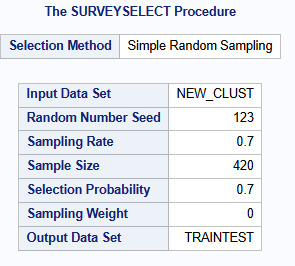
Statistics for variables
proc surveyselect data=new_clust out=traintest seed = 123
samprate=0.7 method=srs outall;
run;
method = srs specifies that the data are to be split using simple random sampling.
out=traintest to include both the training and test observations in a single output data set that has a new variable called selected.
The selected variable is 1 when an observation belongs to the training data set and 0 when an observation belongs to the test data set.
In cluster analysis, variables with large values contribute more to the distance calculations. Variables measured on different scales should be standardized prior to clustering. So, that the solution is not driven by variables measured on larger scales. We use the following code to standardize the clustering variables to have a mean of zero and a standard deviation of one.
proc standard data=clus_train out=clustvar mean=0 std=1;
var age sex region income married children car save_act current_act mortgage; run;
Figure 3

The Elbow curve
%macro kmean(K); indicates that the code is part of a Sass macro called knean and the K in parenthesis indicates that the macro will run the procedure code for number of different values of K. the output is then printed and the output data sets for K from 1 to 11 clusters is created.
Figure4
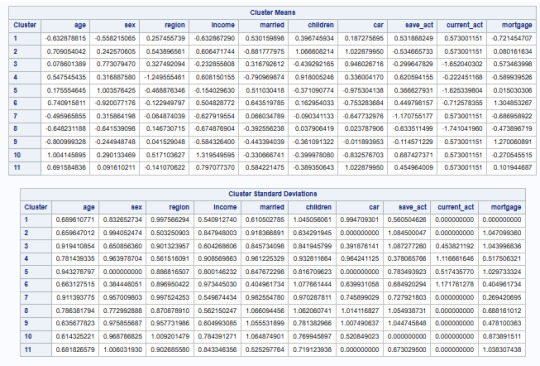
To view the different R-squared values for each of the k equals 1 to 11, the elbow plot is drawn as shown in the figure 5. We start with the K equals 1 with an R-squared=0 zero because there's no clustering yet. 2 cluster solution accounts for about 13% of the variance. The R-square value increases as more clusters are specified. We are looking for the bend in the elbow that shows where the R-square value might be leveling off. From the graph we can notice that there is a bend at 2 clusters, 5 clusters, 7 clusters, and 10 clusters. To help us figure out which solutions is best, we should further examine the results for the 2, 5, 7, and 10 cluster solutions.
Figure 5
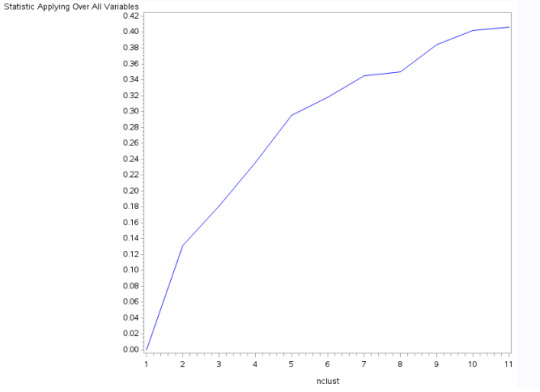
The Canonical discriminate analysis
We should further examine the results for the 2, 5, 7, and 10 cluster solutions to see whether the clusters overlap or the patterns of means on the clustering variables are unique and meaningful and whether there are significant differences between the clusters on our external validation variable, PEP. We will interpret the result for the 5 cluster solution.
Since we have 10 variables, we will not be able to plot a scatter chart to see whether or not the clusters overlap with each other in terms of their location in the 10-dimensional space. For this, we have to use the canonical discriminate analysis which is a data reduction technique that creates a smaller number of variables that are linear combinations of the 10 clustering variables. Usually, the majority of the variants in the clustering variable will be accounted for by the first couple of canonical variables and those are the variables we can plot.
Figure 6
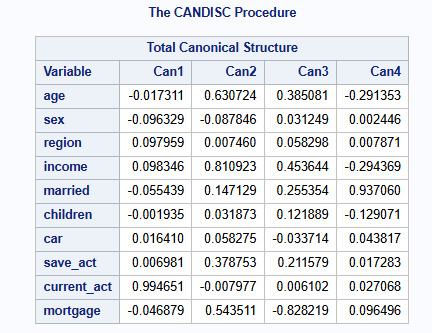
Results in Figure 6 show that the 10 variables are now reduced to 4 canonical variables that can be used to visualize the location of the clusters in a two or three dimensional space as shown in Figure 7.
Figure 7

What this shows is that the observations in cluster 5 is little more spread out, indicating less correlation among the observations and higher within cluster variance. Clusters 2 and 3 are relatively distinct with the exception that some of the observations are closer to each other indicating some overlap with these clusters. The same thing applies to cluster 2 and cluster 4. However, cluster 1 is all over the place. There is some indication of a cluster but the observations are spread out more than the other clusters. This means that the within cluster variance is high as there is less correlation between the observations in this cluster, so we don't really know what's going to happen with that cluster. So, the best cluster solution may have fewer than 5 clusters.
Cluster means table
We will consider for the rest that k=5. We will take a look at the cluster means table to examine the patterns of means on the clustering variables for each cluster which was shown in Figure8.
Figure 8

The means on the clustering variables show that compared to the other clusters, customers in cluster 2 and 5 have relatively good income, a current and saving accounts with no mortgage while customers in cluster 1 and 3 they have a low income, married and less number of children. Cluster 4 includes customers with a low income, low saving account and a mortgage.
Fit criteria for pep
The last part of this analysis will show how the clusters differ in PEP. We first have to extract the PEP variable from the training data set, then sort both data sets by the unique identifier, ID num which we will use to link the data sets and finally merge it with the data set that includes the cluster assignment variable.
The graph in Figure 9 below shows the mean PEP by cluster. As it was described in the mean table before, customers in cluster 1 and 3 they have a low income, married and less number of children so these customers will be certainly accorded a PEP with 60% while customers in cluster 2 and 5 who have relatively good income, a current and saving accounts with no mortgage will be accorded also a PEP with 40%. However, customers in cluster 4 with a low income, low saving account and a mortgage will be accorded a pep with 25% as this is logic as they already have mortgage.
Figure 9
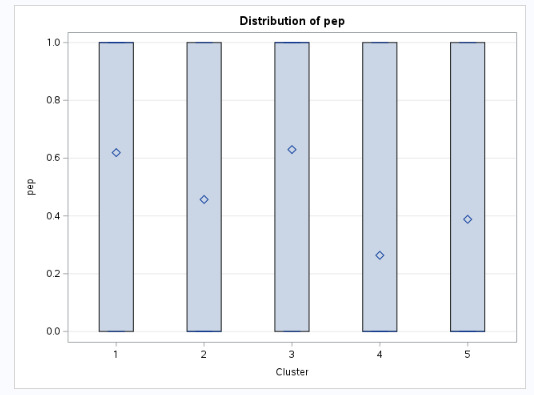
The tukey test
The anova procedure is used to test whether there are significant differences between clusters and PEP as follows:
proc anova data=merged;
class cluster;
model pep = cluster;
means cluster/tukey;
run;
The tukey test shows that the clusters differed significantly in mean PEP as shown in figure 10, with the exception of clusters 2 and 3, which did not differ significantly from each other.
Figure 10
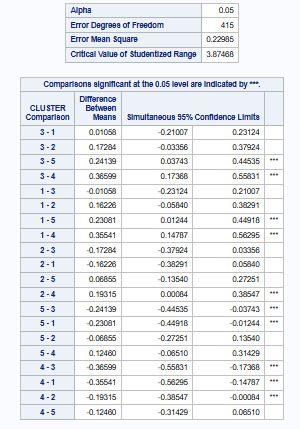
Conclusion
Kmeans is Cluster analysis is an unsupervised learning method used to group or cluster observations into subsets based on the similarity of responses on multiple variables. It is a useful machine learning method that can be applied in any field. However, k-means cluster analysis will have to give us the correct number of clusters and figuring out the correct number clusters that represent the true number of clusters in the population is pretty subjective. Also, if results can change depending on the location of the observations that are randomly chosen as initial centroids. It also assumes that the underlying clusters in the population are spherical, distinct, and are of approximately equal size. As a result, tends to identify clusters with these characteristics. It won't work as well if clusters are elongated or not equal in size.
0 notes
Text
Complaint Handling Procedure for Medical Devices
Complaint handling procedures for medical devices are crucial to ensure the safety, quality, and effectiveness of the devices, as well as maintaining compliance with regulatory requirements. Here is a general outline of a complaint-handling procedure for medical devices:
1. Definition of Complaint: Clearly define what constitutes a complaint. A complaint can be any written, electronic, or oral communication from a customer, user, patient, healthcare professional, distributor, or any other stakeholder expressing dissatisfaction, concern, or potential adverse event related to a medical device.
2. Complaint Receipt and Documentation:
- Designate a responsible person or team to receive and document complaints.
- Establish a system for capturing complaint details, including the complainant's contact information, device information, date of occurrence, description of the issue, and any relevant attachments.
3. Initial Assessment:
- Evaluate the complaint to determine its severity and potential risk to patients, users, or the quality of the device.
- Classify the complaint as major, minor, or non-conformance based on the impact and risk level.
4. Investigation:
- Initiate an investigation into the complaint. Gather relevant information, records, and data.
- Assign responsibilities for investigating the complaint, which may involve quality control, regulatory affairs, engineering, clinical, and other relevant departments.
- Identify the root cause of the complaint and its contributing factors.
5. Risk Assessment:
- Assess the potential risk and impact associated with the complaint. Use risk management techniques to determine the severity and likelihood of recurrence.
- If the complaint relates to a serious adverse event or potential patient harm, consider reporting it to the relevant regulatory authorities in accordance with regulatory requirements.
6. Corrective and Preventive Actions (CAPA):
- Develop and implement appropriate corrective and preventive actions based on the investigation findings.
- Ensure that CAPAs are designed to address the root cause and prevent similar issues from occurring in the future.
- Assign responsibilities for implementing CAPAs and set deadlines for completion.
7. Communication and Feedback:
- Communicate with the complainant regarding the resolution of the complaint, actions taken, and any necessary follow-up.
- Provide feedback to relevant departments regarding the complaint's outcome and the effectiveness of implemented actions.
8. Documentation and Record Keeping:
- Maintain detailed records of the complaint, investigation, risk assessment, and actions taken.
- Ensure all documentation is organized, stored securely, and easily retrievable for future reference or regulatory audits.
9. Trending and Analysis:
- Regularly review and analyse complaint data to identify trends, recurring issues, and opportunities for continuous improvement.
- Use the information gained to enhance the device design, manufacturing processes, and overall quality.
10. Training and Review:
- Train employees involved in complaint handling on the procedure, regulatory requirements, and best practices.
- Periodically review and update the complaint handling procedure to ensure it remains current and effective.
Remember that complaint-handling procedures can vary depending on the specific regulatory environment and the type of medical devices your organization deals with. Always ensure compliance with relevant regulations and standards, such as ISO 13485 and applicable regional regulations (e.g., FDA in the United States, EU MDR in the European Union).
IZiel works with medical device companies to effectively manage Complaints Handling, thereby, helping you provide better, safer, more effective & quality product.
0 notes
Photo
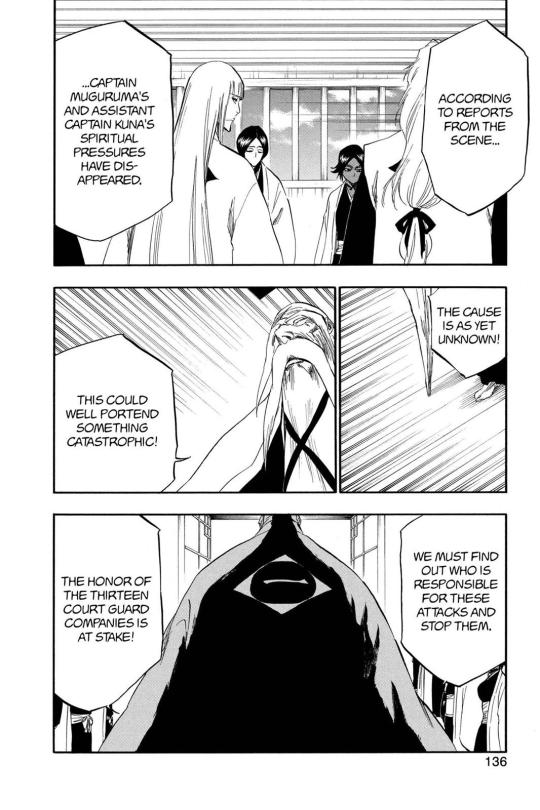


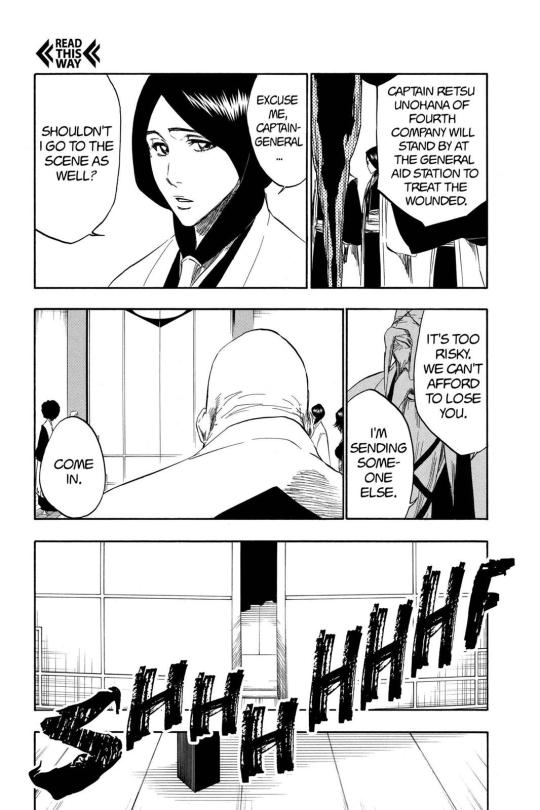

Critical Analysis & Tactics I (CAT-1): The Hollowfication Incident
How strong is Yoruichi? That’s actually a very involved question. I’ve decided to create a series of articles detailing my thoughts on the matter by looking at military incidents and confrontations involving her. This is the first, and you may consult the others at your leisure:
CAT-2: The Central 46 Trial Breakout
CAT-3: Yoruichi vs. Byakuya
CAT-4A & B: Yoruichi vs. Soifon
CAT-5: Yoruichi & Soifon vs. Aizen
CAT-6: Yoruichi vs. Yammy
CAT-7: Yoruichi, Kisuke, & Isshin vs. Aizen
CAT-8: Yoruichi & Co. vs. Yhwach
CAT-9: Yoruichi vs. Askin
I’ve talked about this topic before (here) but I’d like to investigate it again from a different angle while also discussing what really happened on the night of the Hollowfication Incident. I think the five pages above tell you something very important about her strength, particularly the bottom-left one. These are from chapter -103 and are Yamamoto’s orders after Kensei, Mashiro, and the upper officer corps of the 9th Division (the Muguruma Commando Unit) go “missing”. (I’ve omitted Kisuke’s interruption as it doesn’t reveal much that’s pertinent to this discussion.) We learn an awful lot from these orders and it’s worth going through it all in some detail in order to get to my point.
Since the is is a long post, let me put the conclusion here up front: Yoruichi is much stronger than the average Taichō of the Gotei 13.
01. I would, quite aside from these pages, first like to remind the reader that nominally the Gotei 13, Onmitsukidō, and the Kidō Corps are equal in their status of reporting to Central 46. The Onmitsukidō and the Kidō Corps do not report to the Gotei 13. This means that accordingly, the Captain-Commander (Yamamoto), the Supreme Commander (Yoruichi), and the Corps Commander (Tessai) are technically co-equal in official stature; you might regard them as roughly equivalently ranked, being like the Joint Chiefs of Staff of their respective branches. (Jūshirō’s shock and Shunsui’s comment that Tessai’s presence indicates, “This is turning into a big deal,” is proof of that.)
Yamamoto, by virtue of seniority over the other two (and Yoruichi’s dual-hatted command within the Gotei 13) still commands their respect (as evidenced by Tessai addressing him formally and Yoruichi heeding his orders without question) and might be thought of as being like a Chairman of the Joint Chiefs of Staff as a result. I’m not arguing at all that Yoruichi and Tessai are equal in strength to Yamamoto, as they plainly are not. However, you would expect by virtue of these positions that they would be more powerful than run of the mill Taichō, and I believe this sequence of events proves that.
02. Notice in the second page that Yamamoto says that 5 Taichō will be dispatched to deal with the situation. This does seem to be an accurate translation by Viz as the red characters, 隊長 (taichō) and 五 (go), do indeed mean “Captain” and “five”.

He will then proceed to name (on page 3) Rose, Shinji, and Love, and then to indicate Tessai and Hachigen (on page 5). Thus: even though he is the Lieutenant of the Kidō Corps, Hachigen’s equivalent rank in the Gotei 13 would be Captain! He is a Taichō-level combatant, which fits in well with his performance alongside Soifon against Barragan. That he is actually lower ranked than Tessai despite this tells you that Tessai is likely notably stronger (which is subsequently borne out). Shunsui is the one to suggest that Tessai be substituted with Lisa, to which Yamamoto agrees.
03. Agreeing to this fits into Yamamoto’s other behavior. Let’s talk about him first. The important thing to understand about Yamamoto is that we perceive him very differently as a character (because of our point of view) than how the characters themselves perceive him in-universe. To your average reader, he probably seems staid, close-minded, overly conservative, dispassionate, and stubborn, precisely because he supports (and substantially built!) the status quo. However, he is supposed to be the most experienced, wise, and powerful Shinigami there is. And, in fact, he is.
Consider things from Yamamoto’s perspective. Things in the Gotei 13, the Seireitei, and Soul Society as a whole have worked for over 2,011 years as of TBTP. (The graduating class of about 1956, which Renji, Momo, Kira, and originally Rukia were part of, is definitively established as the Academy’s 2066th graduating year, meaning the Academy was founded circa 110 BC.) That compares quite favorably to the longest continuously extant human state, the Pandyan Empire, which lasted for about 1,850 years. The runner up is the Eastern Roman (or Byzantine) Empire which lasted 1,123 years by itself (add 499 more if you want to count the whole Roman Empire too, as the Byzantines themselves would’ve). That’s pretty good. It tells you something: Yamamoto’s system works (largely because he guarantees its continuation through his own personal power).
And Yamamoto generally conducts himself rather cautiously and methodically. He doesn’t like change, spontaneity, or impulsivity, regardless of how justifiable it may or may not be. (These are all things Ichigo initially represents.) And actually, as a soldier, that is probably exactly the kind of commanding officer you would really want to serve under: one who doesn’t take wild risks which might get your ass killed. People respect Yamamoto not just for his strength, but because he’s actually good at what he does.
04. Before we talk about what his orders actually are, I want to make a brief digression here to make a point: only Taichō-level combatants actually matter in the Gotei 13 in terms of military calculations. This is firmly established by the Soul Society arc. Byakuya says this in chapter 162 about bankai:

The key takeaways:
Members of the Great Noble Clans are stronger than everyone else (making people like Yamamoto, Retsu, Aizen, and Kenpachi extreme anomalies)
Even members of the Great Noble Clans only rarely achieve bankai (which, given a Shinigami generation is much longer than a human one, is saying something)
People who achieve bankai are uniformly important to Soul Society
You know who has bankai? Renji, a Fukutaichō who just achieved it and had used it in open combat against Byakuya, a feat which everyone with spiritual sense should’ve detected at the time given it, as Yoruichi notes elsewhere, makes one 5 to 10 times stronger. (Recall how on the Senzaikyu Bridge, everyone felt Ichigo’s approach even though he didn’t have bankai yet.) So Renji’s feat should be very impressive and important, right? Not to Yamamoto. In chapter 153, he already told us:


Renji is expendable. He could be killed and replaced without issue. Yamamoto then goes on to even further establish that Fukutaichō are comparatively useless by effortlessly crushing Nanao with his reiatsu alone in chapter 155. In short, Yamamoto does not rate bankai by itself. (The sole exception to this attitude by Yamamoto is perhaps toward his own Fukutaichō, Sasakibe.) It should also be extremely self-evident that Taichō-level combatants can have an extremely wide separation in power from one another, and I’m not going to substantiate that assertion here because we’d be here all day. So, when we talk about what happens during the Hollowfication Incident, let’s do so with a sense of clarity that only Taichō really matter in Yamamoto’s calculations.
05. Having established that, let’s return to the pages and talk about Yamamoto’s orders and how he’s positioning his forces on this particular night. A summary:
1st: Yamamoto - defense
2nd: Yoruichi - standby
3rd: Rose - deployed
4th: Retsu - defense
5th: Shinji - deployed
6th: Ginrei - defense
7th: Love - deployed
8th: Shunsui - defense
9th: Kensei - MIA
10th: n/a - office unfilled
11th: Kiganjō - no orders
12th: Kisuke - no orders
13th: Jūshirō - defense
The Gotei 13 had 12 Taichō at the time, as the 10th Division’s had died and not been replaced yet. Kensei was at this point MIA, thus putting them at 11. Including Tessai and Hachigen (as noted earlier) bumps them back up to 13. This tells us why the Kidō Corps was brought in: to bring the Gotei 13 back up to full strength during this crisis.
Yamamoto directly assigns his oldest and most experienced subordinates (Shunsui, Jūshirō, and Ginrei) to the defense of the Seireitei. His orders to Retsu to stay and his own continuing presence mean that indeed all the oldest and seemingly strongest Taichō are allocated to defense and garrison duty.
Rose, Shinji, and Love are deployed (along with, initially, Tessai and Hachigen) to investigate.
Kiganjō and Kisuke aren’t issued orders, presumably because both are considered unreliable. Kisuke is there, if late, but is effectively dismissed after his outburst regarding Hiyori.
Yoruichi is designated as the only flexible element in this plan. Before I return to this final point, I want to address some lingering matters and then explain to you what this deployment actually means.
First, It’s notable that Yamamoto’s assertion that Retsu is “too important” is a reflection of her healing abilities and their importance to a potential wartime situation. (Note that Kisuke, in chapter 227, dismissed Orihime from the war effort against Aizen by saying that 4th Division, particularly Retsu, more than equaled her abilities.)
Second, the substitution of Lisa for Tessai (at Shunsui’s suggestion) is not a reflection on Lisa’s power (remember: Fukutaichō don’t matter, and Lisa didn’t have bankai at this time anyway). It’s suggested because of the risk of sending Tessai and Hachigen together. It’s presumably approved because of the seeming overabundance of force in the deployed unit.
What do I mean by that? Think about it this way: a Taichō and his subordinates go missing. While that is (very) concerning, consider the ways in which it is likely to happen. Is it likely to be a Hollow? Almost certainly not. It suggests an ambush. Which in turn suggests a coordinated military strategy. By whom? Unknown. So, how do you respond? You respond in force, but there is probably such a thing as too much force. After all, what is likely to take out 4 Taichō, let alone 5? Not a lot. So the difference between 4 and 5 doesn’t much matter, and substituting Lisa for Tessai is fine. The deployed force should still be overkill either way.
It also retains Tessai for defense, and Yamamoto’s real concern here is revealed by his allocation of a preponderance of forces to the Seireitei: he seems to believe this is a diversion in preparation for an attack on the Seireitei itself. Thus, through action and inaction alike, he commits 4 Taichō to deployment and retains 9 for defense. He is overwhelmingly interested in defense against possible follow-ups and believes he has likely still committed excessive force to deal with whatever Kensei’s situation is.
06. Thus, finally, we come to Yoruichi’s role in this plan as the the only mobile auxiliary force. Let me state my premise first, then I’ll substantiate it: Yoruichi is the only possible backup the deployed force has, meaning she and she alone is their lifeline in the event something goes wrong—this fact alone tells you she is more powerful than the deployed force as a whole. In other words, Yoruichi is stronger than Kensei, Rose, Love, Shinji, Tessai, and Hachigen put together.
Bold claim, I’m sure! What evidence do I have to support this assertion? I tell you it’s simply obvious using conservative tactical logic, studying their military disposition, and understanding the political situation.
Tactical logic first: suppose for a second that there was an unknown criminal incident in a local big box store like Walmart, Home Depot, or whatever you like. A squad car’s worth of cops (2) went in. They then stopped responding to central. So, backup is ordered and now four times as many cops go in (8). What if they stop responding? Would you send in another 2 cops? Or 8? Or even 10? No. You would likely send in at least 20–30, if not just the local SWAT team. It doesn’t make sense, after having lost so many elements already, not to escalate radically, just as sending 8 guys is a radical escalation from sending 2. You don’t send 2, then 8, then somewhere between 2 and 10 yet again. You’re throwing away limited forces for no gain at that point.
Yoruichi is the SWAT team. The fact Yoruichi alone was the potential reinforcements for the deployed group tells you that one of two things is true:
Yoruichi is stronger, unto herself, than the deployed group, or...
Yamamoto was prepared to simply sacrifice the deployed group if the situation went bad, and their backup, for no gain
Military disposition second: given Yamamoto is already working with a diminished and very finite force, with possibly 2 out of 13 Taichō down, (2) does not make a lot of sense given his character. (Again: note how he reserved Retsu and Tessai out of strategic concern.) What is the benefit? It is worth noting here that after the defection of Aizen, Gin, and Kaname a century later, the Seireitei also adopted a conservative and defensive posture (but more on this later).
Political situation third: doing this also wouldn’t make a lot of sense given the state that the Gotei 13 was in as a whole at the time, which Shunsui and Jūshirō helpfully expounded upon in chapter -108:



Long story made short, the Gotei 13 was in a period of upheaval and turmoil at the time—a period of weakness. Sacrificing your military assets when you are weak is not particularly intelligent.
We can thus recast our two earlier possibilities as follows:
Yoruichi is in fact incredibly strong, or...
Yamamoto is a military idiot who wasted forces for no good reason, despite the fact he is supposed to be extremely militarily competent
I know which of those two my money is on. But I’m also not done yet in proving it.
07. Let’s be very clear here that the events of the Hollowfication Incident were the most extreme losses we know of that the Gotei 13 ever suffered in terms of assets that actually mattered. The Gotei 13 lost a grand total of 8 Taichō-class combatants that night (Yoruichi, Kisuke, Tessai, Hachigen, Shinji, Rose, Love, and Kensei). Their strength was reduced from 14 acting with the Kidō Corps to 6. That’s 57.12% losses. From this perspective, it was a much worse disaster than Aizen’s defection or the Wandenreich War in terms of outcome. The loss of both the Supreme Commander of the Onmitsukidō and the Corps Commander of the Kidō Corps was especially grievous.
It’s also worth pointing out that as far as Central 46 was concerned the Hollowfication Incident was a conspiracy orchestrated by Kisuke, Tessai, and by proxy Yoruichi. Given the losses, it can only be read as an attempted coup, and other than Aizen’s murder of Central 46, was a much more serious event than even Aizen’s defection.
This raises a simple question: Why didn’t Central 46 demand Yoruichi, Tessai, and Kisuke be hunted down?
The first and most obvious answer is that numerically the forces to do so while maintaining the defense of the Seireitei simply did not exist. Only Yamamoto, Retsu, Ginrei, Shunsui, Kiganjō, and Jūshirō were left. Kiganj�� was plainly unsuited for such a mission. Retsu would be even more critical after such losses and would never be sent. Ginrei, Shunsui, and Jūshirō were exactly the ones tasked with securing the Seireitei and could be thought of as the ‘minimum’ needed to do that. And finally, it’s unlikely that Yamamoto himself would go, even though he later states to both Shunsui and Jūshirō in chapter 154 that:

Put simply: Yamamoto didn’t have the manpower to chase them. (And Yamamoto would make a very similar decision after Aizen’s defection, choosing not to pursue him, Gin, and Kaname to Hueco Mundo, which he likely regarded as being a giant trap he could ill afford to take loses from; he learned from the Hollowfication Incident!)
But that isn’t the only answer, because even when he later did after the Gotei 13 was reconstituted, he wasn’t interested in tracking them down. This is surely not because they were just written off as dead (as Byakuya implies on the Senzaikyu Bridge) given the enormity of the accusations against them. The Gotei 13 didn’t give up on tracking down Ginjō and Xcution for far less; it isn’t in the business of forgiving or forgetting.
Maybe Yoruichi choosing to spare Central 46′s lives factored into that decision (see here) but if it did, doesn’t, “She might come back and kill us all and there’s nothing we could do to stop it,” tell you she’s very strong?
And if that didn’t affect the decision-making process, what did? I’ll tell you plainly: Yamamoto did not have confidence that any team he could afford to send out was likely to beat Yoruichi, Tessai, and Kisuke—and he didn’t think much of Kisuke. That should also tell you that Yoruichi is very strong.
The Urahara Shōten crew was allowed not only to escape but to live in peace not just because of whatever actions that might have taken to protect themselves, but because a military confrontation with them was simply too risky. And a major component of that risk must, logically, be that Yoruichi is extremely strong.
The anime-only Reigai Uprising filler arc is exactly that—filler—but it is known that Kubo was at least consulted for the filler arcs. And during that filler arc, in episode 319, Yoruichi’s Wiki entry notes the following:
She fought three Shinigami captains and four lieutenant-level and above opponents at the same time with Hakuda without receiving any notable damage.
All of the above is in my opinion convincing evidence that although this feat is non-canon, it would be very plausible for it to happen in canon. That’s how strong Yoruichi is. That is why she is the designated threat barometer (see here) for the latter half of the series. Yoruichi is not arrogant. This whole sequence is designed to tell you as much.
P.S. Since I'm also vaguely talking about this: yeah, Yoruichi didn't beat Askin. But you know what? Mayuri didn't beat Pernida, Shunsui didn't beat Lille, and Byakuya, Tōshirō, Kenpachi, and the rest didn't beat Gerard. None of the Sternritter were beaten by their primary opponents. And, for the record, Yoruichi did better against Askin than Ōetsu did, without a ridiculously overpowered zanpakutō and with a much stronger Askin, as Yhwach hadn't yet absorbed the Soul King and powered up the Sternritter when Ōetsu confronted them. Just sayin'...
33 notes
·
View notes
Text
Latest webull review [2021]: Starting with a $1 investment.
Latest webull review [2021]: Starting with a $1 investment.
Webull provides a multi-features experience for investors and all in one solution.
Webull review at a Glance:
Webull is founded in 2017, and it is a mobile app-based brokerage that features commission-free stock and exchange-traded fund trading. It runs by the Securities and Exchange Commission (SEC) and the Financial Industry Regulatory Authority (FINRA). Webull trading platform is designed for beginner, intermediate and experienced traders.
Where is webull based: Webull is an American broker-dealer headquartered in New York City
Webull is safe because it is regulated by top-level financial authorities.it provides a maximum of $500,000 investor protection, including a $250,000 limit for cash under the Securities Investor Protection Corporation's (SIPC) protection scheme. It is part of Webull Financial LLC and is licensed to carry out brokerage activities in all 50 United States.
Is webull good for trading?
Webull doesn't have a minimum deposit requirement to get going. You can join Webull and start investing with just a few dollars. Webull offers some of the most competitive margin rates in the industry. And unlike main rival Robinhood, Webull doesn't require a subscription. Many brokers' website offer cash bonuses for new account creators, but that only after users meet certain minimum deposit requirements. Webull gives free stocks to customers with small deposit thresholds. These stocks are worth anywhere from $2.40 to $1,500 per share. Currently, just $100 is required for the best bonus. It will offer you a unique community experience.
Eligibility of Joining Webull:
1. Webull only accepts account applications from U.S. residents. 2. You will need to be at least 18 years old to create an account. 3.you have to verify your US identity and residency status. 4.YOU have to upload a copy of your government-issued ID, and your social security number.
How to create or open an Account on Webull?
You must open an account on the app>Then Choose your account>make sure you have selected the right type of brokerage account>Add personal info >Identify yourself >Seal the deal>Fund your account>enjoy.
How long does webull take to approve?
Most account applications will approve within one hour. It might take more time if your application needs further verification.
Advantages and disadvantages of Webull:
Advantages:
1. Webull offers commission-free US stock, ETF, and options trading with no inactivity fees. 2. No minimum deposit requirement 3. Zero commissions on trades 4. Several asset classes available to trade 5. Cryptocurrency trading 6. After-hours trading available 7. Advanced charting 8. Level 2 data from NASDAQ available. 9. Traditional, Roth, and rollover IRAs available 10. App, web, and desktop platforms available Paper trading.
Disadvantages:
1. Does not support trading in mutual funds 2. Does not support trading in bonds 3. Does not support trading in OTC stocks
Webull’s total Commissions and Fees: Webull is Really Free!
The enticement of fee-free trading in the online investment space has seen a big change in the industry. Traditional brokers are now being challenged by start-up platforms that have found a way to make money without charging their investors. Webull users can connect real-time U.S. market data completely free. This indicates not only real-time price quotes but income statements, balance sheets, and cash flow reports. Minimum Deposit-$0.00 Stock Trades -$0.00 Stock Trades (Per Share)-$0.00 ETF Trade Fee-$0.00 Mutual Fund Trade Fee- free Base Fee-$0.00 Exercise Fee-$0.00 Assignment Fee-$0.00 Per Contract-N/A Broker Assisted Trades Fee-N/A
Webull and others:
Robinhood is Webull’s main competitor. Both companies are trying to be Walmart brokers by offering the lowest price possible to those looking for bargains. Those bargain-seekers are by and large millennials, this is why both companies took a mobile-first approach and only developing desktop and web apps after establishing themselves in the trading industry.
Another one is TD Ameritrade. After testing 11 of the best online brokers over the years, TD Ameritrade is not better than Webull. Webull delivers $0 trades, fantastic trading platforms, excellent market research, industry-leading education for beginners, and reliable customer service.
Webull vs. Robinhood: Commission and Fees
Undoubtedly, commissions and fees are a big part of the whole picture. We compare Webull and Robinhood wide open in order to evaluate both.
Webull’s Fees:
Webull has no fees or commissions on any stock or ETF trade. All you will pay is the spread and SEC transaction cost, those are the portion of a copper penny. You can transfer money in and out of your account without fees using ACH, as domestic wire transfers cost $8 per deposit and $25 per withdrawal.
Global wire fees are $12.50 and $45, respectively. Margin rates start are 6.99% for up to $25,000.
Robinhood’s Fees:
Robinhood is also commission-free on all trades, including options and cryptocurrency trades. Surplus is available over Robinhood Gold, but there’s a $5 monthly fee.
The first $1,000 of margin can be borrowed interest-free, and you will get it as a bonus. After $1,000, rates are 5% only. Only ACH transfers are permitted to fund your account, so there will be no fees on deposits or withdrawals.
Webull’s finest Customer Support:
Webull’s customer support is often accessed through email, which is not that the only method mentioned on its website, but also there is an online web chat option or telephone number. Moreover, Webull’s customer service does reply within 1 hour of a question.
Only Webull’s help page offered any sort of customer support, then only within the sort of FAQ.
Webull’s FAQ page does offer you detailed information on opening an account and therefore the funding and transfers of money and stocks. It also features a Trading on Webull section with information about commissions and costs, tradable assets, and order types.
The FAQ sections found on the assistance page can answer your basic questions. Email Webull for more details or to talk with a Webull agent for more information or further assistance.
Webull referral system:
Along with their account creation promotion, Webull additionally offers a Refer-a-Friend form of program. However, this small little bit of promotion is slightly less simple in terms of the manner that their directions are read.
Unfortunately, you won’t receive any free stock just because an addict you refer exposes a replacement account. This friend can get to deposit a minimum of $100 among the first thirty days of their account being open for you to reap the rewards.
A decent side to the current incentive is that you simply will repeat it indefinitely, with decreasing returns when the first 2 referrals have met completion requirements.
In keeping with their terms and conditions, which are additional clearly worded than the promotion itself, the benefits of the referrals are as follows:
Upon completion of your first undefeated referral, you'll receive four free stocks.
Your second successful referral can award you with seven free stocks.
Every resultant referral will award you two additional stocks.
This stock choice pool is analogous to the one antecedent represented among the account gap promotion. They're aiming to be from firms listed on the New York Stock Exchange or information system that are U.S. based mostly and have a minimum market cap of $2.5 billion.
However, not like the account gap promotion, there will appear to be a one/50 or 1/100 likelihood to accumulate securities from bound companies. however, it does follow identical odds to your initial $100 deposit.
Odds of stock valued at $8 to $30 approx. 1 in 1.02
Odds of stock valued at $30 to $100 approx. 1 in 52.63
Odds of stock valued at $100 to $200 approx 1 in one,111.11
Odds of stock valued at $1,000 to $1,600 approx 1 in 10,000
FAQs for Webull
How does Webull make cash?
Webull doesn’t make money from trade commissions that makes many of us surprise, however, the corporate makes money. Webull makes money from the subsequent revenue streams:
Margin rate: This represents interest paid to Webull once people borrow money to invest.
Stock loans: Webull might lend securities and make the most of loaning those securities. Your securities are still out there if you wish them.
Interest on free credit balances: money sitting in your account doesn’t pay interest to you, however, Webull will earn interest on it.
Is Webull smart for beginners?
Webull might be a good choice for lettered beginner investors that perceive investments in construct however haven't started commercialism yet. New investors who are learning the way to invest cash would probably be higher suited by different platforms that provide a lot of instructional resources. Fully new investors might like Robo-advisors that guide them through the finance process.
Is Webull legit and reliable?
Yes, Webull is a legitimate brokerage you'll use to take a position in stocks, ETFs, crypto, ADR's, and options. It's registered with the SEC and is a member of FINRA, SIPC, NYSE, NASDAQ. Webull’s customers rise up to $500,000 of coverage just in case the brokerage fails, and your securities go missing.
A final thought about Webull:
Webull is a well capable brokerage app for North American country traders. The app offers absolutely commission-free commerce with no account fees, so it’s really a cheap choice for purchasing and merchandising stocks, ETFs, options, and cryptocurrency. We also like that Webull provides traders access to almost the whole US stock market, with the notable exception of penny stocks.
What really sets Webull different from other brokerage apps is that it offers a big variety of advanced charting and analysis features. You'll read extremely customizable technical charts for any plus furthermore as fully customize any of fifty popular indicators. Webull conjointly permits you to import Level a pair of Advance knowledge from the information system, so you'll track order flows through the market.
In addition, the app includes analyst recommendations and worth targets for many widespread stocks. A basic social network lets you see what different traders place confidence in different assets and swap ideas.
Webull is rising as a legitimate challenger and various to Robinhood, growing its client base to a possible variety of two spots among online brokers serving retail traders. This relative newcomer within the zero-commission online commerce world endlessly broadens its merchandise to satisfy its clients and leverage its commerce platform. Webull brokerage is best for those who will handle their own customer service and have some investment information and experience. If this looks like you, positively take into account giving Webull a try and take the benefits of webull.
6 notes
·
View notes
Text
The Changes of Homocysteine Serum Level and Body Mass Index of Overweight Young Women after Eight Weeks of Pilates Exercise | Juniper Publishers
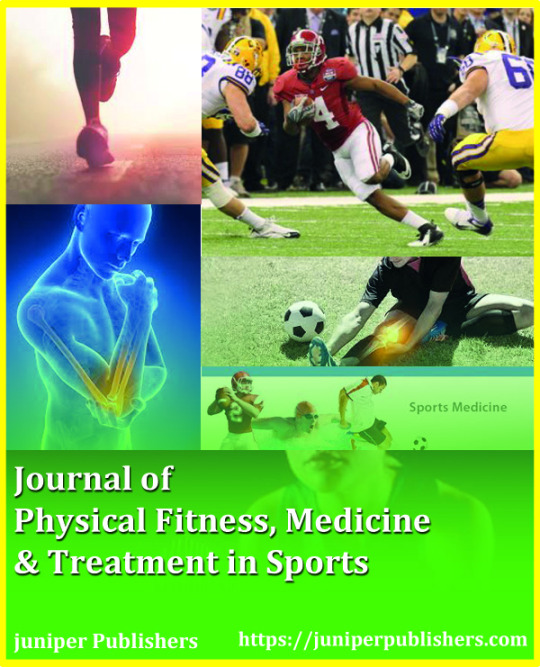
Juniper Publishers- Journal of Physical Fitness, Medicine & Treatment in Sports
Introduction
The increasing trend of obesity is one of the most major public health concern and health related issues [1]. According to an epidemiologic study conducted in 199 countries around the world in 2008, 1.46 billion adults were overweight. The scope of the outbreak obesity is varying substantially between nations, largest rise in Oceania and the lowest trend was estimated in India [1]. In the USA, 34 percent of adults aged above 20 suffered from obesity in 2008. in addition, East Mediterranean countries estimated an increased by over 20% [2]. A review study indicated that obesity reached an alarming level in all ages of the East Mediterranean countries. the spread development of obesity has been ranged from 25 to 81.9 percent among adults [3]. In the same vein, a research of systemic review has conducted a study regarding the effect of BMI on cardiovascular diseases which indicated that each 5 unit raised in BMI increases the chances of heart problems by 29 percent [4].
Homocysteine is considered to be associated with microalbuminuria, which is a serious indicator of the risk factor of future cardiovascular disease. Homocysteine is also known to mediate heart attack, whenever its level raises, the risk of arterial artery problems such as atherosclerosis would increase [5,6]. It is a phosphor containing amino acid which is formed during methionine metabolism [7]. Epidemiology studies revealed that high levels of homocysteine in blood plasma could be a risk factor for cardiovascular, heart attack and peripheral vascular diseases and it causes atherosclerosis through three ways of intra-arterial wall damage, interference in the blood-clotting factors, and the oxidation of low density lipoprotein [8]. The prevalence of hyper homo cysteinemia is estimated to be about 5 percent in the general population and 13 to 14 percent among patients with symptoms of atherosclerosis. However, these estimates are based on a cut above the 90th or 95th percentile of total homocysteine distribution in the general population [7,9]. Various surveys have shown that levels of this amino acid are at a high level in obese or overweight as well as those who do not have regular exercise. Yet, there is debate on the effects of physical activity on this factor [8].
The effect of stair climbing with moderate intensity exercise on cardio-respiratory Fitness, blood lipids, and serum homocysteine were examined among sedentary young women. This study showed that these exercises can favorably make some changes in homocysteine cardiovascular risk factors and blood lipids profiles of inactive young women [10]. Vincent also reported that the decrease in homocysteine level caused by resistive exercises among inactive elderly people in aged of 60_80 [11]. Moreover, no change in homocysteine level had been reported among 6 inactive men who participated in a walking activity with low intensity exercise [12]. In addition, another study showed that homocysteine concentration does not lead to significant changes in sub maximal exercise. Hence, the training intensity, sex and age are the factors affecting the above index [13]. Nevertheless, level of participation and different levels of interest in continuing exercise are the most important keys to reduce weight in overweight population although it may be exhausting. Therefore, doing sport activity such as Pilates can have a prominent role in increasing their interest in exercise (Table 1).
A collection of specialized sport activities affecting body and mind by using special equipment is called Pilates. It can increase power or endurance of whole body and even target the deepest muscles. Pilates exercises include effort for one’s mental concentration on body muscles and how they function. Pilates exercise is named after its founder, Joseph Pilates, who developed a series of exercises in the 1920s to encourage physical and mental conditioning [14]. Strength, more body balanced, flexibility and core stability are emphasized in Pilates exercise to control of posture, movement, and breathing [15]. A survey in this domain showed that Pilates exercise among untrained women for 8 weeks leads to decreased serum creatine kinase, LDL, TG and Cholesterol. They also reported that Pilates increases HDL among these people [16]. Moreover, it has been investigated the effect of 24 weeks of Pilates exercise among elderly women and reported that this activity culminates in increased bone strength and decreased body lipid mass [17]. Nonetheless, there is no conclusive result about the effect of Pilates on homocysteine level and it has not been clearly identified whether the intensity employed in Pilates exercises has any effect on the amount of homocysteine of overweight women. Hence, the present research designed to investigate the effect of 8 weeks of Pilates exercise on protein and mRNA level of serum homocysteine and BMI among overweight young women (Table 2).
Participation and Method
Subject recruitment
The study involved 20 overweight women whose BMI was above 25 from “Tandorosti gym” located in Tehran, Iran. The volunteers had the required features for participation in this project, including; no cardiovascular disease, not consuming special medicine, no smoking, not having a regular exercise. Physiologic characteristics of volunteers including height, weight, age, BMI, heart rate, systolic and diastolic blood pressure were recorded. Participations were well informed about the study prior to the experiment and written consent was obtained from them. A double-blind study method was applied, and the participants were randomly assigned into 2 groups of 10; (1) control and (2) Pilates exercise groups. Pilates exercise group performed Pilates exercise 3 times per week for 8 weeks. It contains movements which engaged abdominal muscles, hips, waist, legs and shoulder belt and it was performed on a mat without any specific equipment in three conditions of sitting, standing and lying down. During this period, the control group was also barred from participating in regular physical activity. Prior the exercise protocol and at the end of eighth weeks, BMI was recorded, and blood sample was collected to measure protein or mRNA level of homocysteine. All procedures involving experiments were carried out in strict accordance of the United States Institute of Research guidelines and approved by the Medical Centre Board of Tehran University (Table 3).
Method of body mass index measurement
The body mass index was calculated by measuring height in meters, weight in kilograms and putting them in the following formula:
Height (m)2 / weight (in kilograms) = body mass index
Blood Sample Collection
Blood samples were collected at 24 hours before the pilates exercise and 24 hours after the last exercise session of 8 weeks training in fasting state through the elbow antecubital vein of all subjects for measurement of homocysteine mRNA and protein expressions.
Measurement of Serum Homocysteine protein
The level of serum homocysteine protein was measured by homocysteine measurement Elisa kit (Axis-shield diagonistmade in Germany). ELISA was performed according to the manufacturer’s instructions. The absorbance for homocysteine was determined by using a microplate reader (iMark; Bio - Rad, Hercules, CA, USA) at a wavelength of 450 nm. A set of standard serial dilutions of known concentrations of homocysteine were provided by the manufacturer and were used to construct a standard curve in order to determine the homocysteine levels. Homocysteine which was attached to protein was changed to free homocysteine and then it was changed to S-adenosyl L homocysteine (Figure 1).
RNA purification and mRNA Expression Analysis by Real Time PCR (qPCR)
QIA amp RNA Blood Mini Kit (Qiagen, Germany) was used to isolate total cellular RNA from fresh whole blood. The concentration and purification of isolated RNA were evaluated by 260/280 UV absorption ratios (Gene Quant 1300, UK). Specific amplification fragments of DNA/RNA, Two-step Real time qPCR (quantitative Polymerase Chain Reaction) technique was used to calculate gene expression during the PCR amplification process with application of TaqMan reagent. This method was able to detect small differences between samples compared to other methods [18]. All reagents including probes and primers were obtained from Applied Biosystems, USA. TaqMan probe (known as fluorogenic 5′ nuclease) was chosen to perform qPCR. This probe has a sensitivity of 100% and a specificity of 96.67% [19] and is capable of detecting as few as 50 copies of RNA/ml and as low as 5-10 molecules [20].
Primers were designed by the same company for homocysteine targets
MRT: Hs01090026_m1; Lot no: 4351372, amplifies 61 bp segment from the whole mRNA length of 10558 bp. Beta Actin and GAPDH were used as reference genes. All amplification experiments were done in 3 biological replicates. Amplification program include 15 minutes at 48 °C (reverse transcriptase), 10 minutes at 95 °C activation of ampli Taq gold DNA polymerase, denaturation at 95 °C for 15 second and annealing at 60 °C for 1 minute. Denaturation and annealing steps were performed for 40 cycles. Step-One Plus real time PCR machine, TaqMan Fast Advanced Master Mix and assays were purchased from Applied Biosystems, USA. The fold changes of each target per average of ACTB were calculated and considered as mRNA expression levels of the target gene. Data was analyzed according to Comparative Ct (2−ΔΔCt) method, where amplification of the target and the reference genes were measured in the sample and reference [18].
Statistical method
In this study, the Kolmogorov - Smirnov was used for the normal distribution of data as well as t-test (paired) for comparing pre-test and post-test stages within each group. Independent t-test was used for between-group comparison of indices in pre- and post-test stages. Pearson’s coefficient and linear regression were used to examine the association between indices. All data in significance level of 05.0 ≥P were examined using SPSS version 21 (Chicago, America) (Figure 2).
Results
BMI
Findings of this research show that 8 weeks Pilates exercise leads to a significant decreased of BMI among overweight women (P=0.001).
Homocysteine protein expression quantification
The findings indicate that homocysteine protein expression levels were significantly increased after 8 weeks Pilates exercise among overweight women compared to control group or pretest (P=0.001).
Homocysteine mRNA expression level
The results also indicate that homocysteine mRNA expression levels were significantly increased after 8 weeks Pilates exercise among overweight women compared to control group or pretest (P=0.0001). However, there was no significant change in the amount of these indices in the control group (P≤0.05). Also, there was no significant difference between the Pilates exercise group and the control group in pre-test stage regarding the homocysteine (P=0.004) and BMI (P=0.001) level.
Discussion and Conclusion
This study reports a significant change in homocysteine level among overweight women after eight weeks of Pilates exercise. Although the comparison of two groups in the pre and post-test stages showed that the Pilates group had a lower level of homocysteine in the post-test stage compare to pre-test or control group, there was no significant change in the control group (P=0.004). A study investigated the effect of aerobic exercise on homocysteine level among overweight women which suffered from polycystic ovary syndrome showed that a 6-week aerobic exercise caused a significant decrease in the level of homocysteine [21]. In addition, similar study reported findings in young untrained women [10]. On the other hand, Di Santolo et al, investigated the relationship between recreational sports and homocysteine level among young women and found no significant change in the level of homocysteine [22].
The effect of two types of exercise on homocysteine level have been examined, as well as other cardiovascular diseases risk factors. It was revealed that a 12-week aerobic and resistive exercise does not make any significant change on the level of homocysteine, lipid profile and maximal aerobic power [23]. Furthermore, Bambaeichi et al, investigated the effect of increasing aerobic exercise on homocysteine level in young men and reported that the level of homocysteine did not have a significant change in the experimental group [24]. Various factors such as; intensity, type, or length of activity, gender or age of the participants have been considered to be effective on the divergent findings of the researchers. However, the effect of exercise on homocysteine can be explored from different aspects. During doing physical activity or recovery, amino acids more likely play an important role in anaplerotic functions sustaining the whole metabolic apparatus, as well as synthesis of other proteins, such as carnitine or melatonine. Increasing the energyreleasing reactions in the muscles; more induction in catabolism of amino acids such as methionine would be increasing. Also, regular sport activities increase renovation and repair muscle tissue by metabolic reactions require.
Since methionine is an amino utilized in protein formation which starting material for numerous biochemical molecules. On the other hand, homocysteine is one of the critical biochemical junctures between methionine metabolism and the biosynthesis of the amino acids’ cysteine and taurine, therefore decreasing methionine leads to homocysteine reduction [25]. There is this possibility that Pilates assists in decreasing homocysteine level and changing homocysteine to methionine leads to prevents its accumulation in the blood through increasing absorption of vitamins which are effective in homocysteine cycle especially group B vitamins (which decrease homocysteine during its menatbolosm) [26]. In addition, reduction of oxidative stress indices of regular exercise can also reduce levels of homocysteine [27]. Also, it is likely that insulin has an impact on homocysteine metabolism and its level through affecting activities of CBS, MTHFR enzymes, Systationine Gamma-lyase and betaine homocysteine methyltransferase [28]. Moreover, it seems that sport activities affect insulin role in decreasing homocysteine by reducing CRP and resistance to insulin [29].
The relationship between body composition and homocysteine is also of great importance. Although in the present study no significant relationship was found between them, BMI totally decreased with homocysteine reduction in Pilates group. The relationship between body composition and homocysteine have been investigated among Korean men and women in aged of 30 to 55 which had high homocysteine level. Findings of their study revealed that increase in total body fat content and decrease in LBM have a significant relationship with increased homocysteine. They reported that decrease in LBM is a suitable index for predicting homocysteine increase in different people [30]. Our findings showed that 8 weeks of Pilates exercise causes a significant decrease in BMI level among young overweight women. However, this change was not considered significant in the control group. In this domain, some consistent and contradictory studies can be mentioned. A 4 week of Pilates exercise on body composition have assessed in young girls. They showed that BMI level, waist size and blood pressure significantly decreased after 4 weeks of Pilates exercise [31]. Another study also explored the effect of two sport activities on indices of cardiovascular patients’ body composition. They declared that BMI level and waist-to-hip ratio significantly decreased compared to pre-test [23]. Alternatively, 5-week Pilates exercise on trunk power, endurance and flexibility among low active adult women had no any significant change in BMI level [32].
Furthermore, no significant change also caused after doing 8 weeks Pilates exercise on fitness indices among low-active women [33]. Similarly, Cakmakçi et al found no significant change of BMI as a result of 8 weeks of Pilates exercise among obese women [34]. It seems as if the amount of subcutaneous fat, exercise intensity and the amount of nutrition control of the participants are among the influential factors with contradictory findings. Different factors can be pointed out regarding the effective mechanisms on Pilates exercise. A negative relationship was reported between body composition and the level of VO2max [35]. It appears that sport activity can be effective in decreasing suitable BMI through increasing Lipoprotein Lipaz enzyme, fat tissue, blood flow, active muscles flow, and expanding the activity of hormones effective in metabolism [36-38]. In the similar vein, it has been reported a significant increase in aerobic power as a result of 8 weeks of Pilates exercise among obese women [39]. In conclusion, findings of this study showed that eight weeks of aerobic exercise significantly decreased the amount of homocysteine serum and body mass index in overweight young women. However, despite BMI level changes caused by Pilates, it seems that BMI decrease is not the major and effective factor on homocysteine decrease among overweight women. Probably there are other factors in this domain which have not been measured in this research. It is considered as the limitation of this study and should be taken into consideration in future researches.
For more Open Access Journals in Juniper Publishers please click on: https://juniperpublishers.com
For more articles in Journal of Physical Fitness, Medicine & Treatment in Sports
please click on: https://juniperpublishers.com/jpfmts/index.php
For more Open Access Journals please click on: https://juniperpublishers.com
2 notes
·
View notes
Text
UGC NET Commerce Books, Question Paper, Free Study Material, MCQ
UGC NET Commerce Books, Question Paper, Free Study Material, MCQ The National Eligibility Test, also known as UGC NET or NTA-UGC-NET, is the test for determining the eligibility for the post of Assistant Professor and/or Junior Research Fellowship award in Indian universities and colleges. UGC NET is considered as one of the toughest exams in India, with success ratio of merely 6%. UGC NET Commerce Question Paper and MCQs Buy the question bank or online quiz of UGC NET Commerce Exam Going through the UGC NET Commerce Exam Question Bank is a must for aspirants to both understand the exam structure as well as be well prepared to attempt the exam. The first step towards both preparation as well as revision is to practice from UGC NET Commerce Exam with the help of Question Bank or Online quiz. We will provide you the questions with detailed answer. UGC NET Commerce Question Paper and MCQs : Available Now UGC NET Commerce Free Study Material : Click Here UGC NET Commerce Books : Click Here UGC NET Commerce Syllabus Unit 1 – Business Environment and International Business Concepts and elements of business environment: Economic environment- Economic systems, Economic policies(Monetary and fiscal policies); Political environment Role of government in business; Legal environment- Consumer Protection Act, FEMA; Socio-cultural factors and their influence on business; Corporate Social Responsibility (CSR), Scope and importance of international business; Globalization and its drivers; Modes of entry into international business, Theories of international trade; Government intervention in international trade; Tariff and non-tariff barriers; India’s foreign trade policy, Foreign direct investment (FDI) and Foreign portfolio investment (FPI); Types of FDI, Costs and benefits of FDI to home and host countries; Trends in FDI; India’s FDI policy, Balance of payments (BOP): Importance and components of BOP, Regional Economic Integration: Levels of Regional Economic Integration; Trade creation and diversion effects; Regional Trade Agreements: European Union (EU), ASEAN, SAARC, NAFTA International Economic institutions: IMF, World Bank, UNCTAD, World Trade Organisation (WTO): Functions and objectives of WTO; Agriculture Agreement; GATS; TRIPS; TRIMS Unit 2 – Accounting and Auditing Basic accounting principles; concepts and postulates, Partnership Accounts: Admission, Retirement, Death, Dissolution and Insolvency of partnership firms, Corporate Accounting: Issue, forfeiture and reissue of shares; Liquidation of companies; Acquisition, merger, amalgamation and reconstruction of companies, Holding company accounts, Cost and Management Accounting: Marginal costing and Break-even analysis; Standard costing; Budgetary control; Process costing; Activity Based Costing (ABC); Costing for decision-making; Life cycle costing, Target costing, Kaizen costing and JIT, Financial Statements Analysis: Ratio analysis; Funds flow Analysis; Cash flow analysis, Human Resources Accounting; Inflation Accounting; Environmental Accounting, Indian Accounting Standards and IFRS, Auditing: Independent financial audit; Vouching; Verification ad valuation of assets and liabilities; Audit of financial statements and audit report; Cost audit, Recent Trends in Auditing: Management audit; Energy audit; Environment audit; Systems audit; Safety audit Unit 3 – Business Economics Meaning and scope of business economics, Objectives of business firms, Demand analysis: Law of demand; Elasticity of demand and its measurement; Relationship between AR and MR, Consumer behavior: Utility analysis; Indifference curve analysis, Law of Variable Proportions: Law of Returns to Scale, Theory of cost: Short-run and long-run cost curves, Price determination under different market forms: Perfect competition; Monopolistic competition; Oligopoly- Price leadership model; Monopoly; Price discrimination, Pricing strategies: Price skimming; Price penetration; Peak load pricing Unit 4 – Business Finance Scope and sources of finance; Lease financing, Cost of capital and time value of money, Capital structure, Capital budgeting decisions: Conventional and scientific techniques of capital budgeting analysis, Working capital management; Dividend decision: Theories and policies, Risk and return analysis; Asset securitization, International monetary system, Foreign exchange market; Exchange rate risk and hedging techniques, International financial markets and instruments: Euro currency; GDRs; ADRs, International arbitrage; Multinational capital budgeting Unit 5 – Business Statistics and Research Methods Measures of central tendency, Measures of dispersion, Measures of skewness, Correlation and regression of two variables, Probability: Approaches to probability; Bayes’ theorem, Probability distributions: Binomial, poisson and normal distributions, Research: Concept and types; Research designs, Data: Collection and classification of data, Sampling and estimation: Concepts; Methods of sampling – probability and nonprobability methods; Sampling distribution; Central limit theorem; Standard error; Statistical estimation, Hypothesis testing: z-test; t-test; ANOVA; Chi–square test; Mann-Whitney test (Utest); Kruskal Wallis test (H-test); Rank correlation test, Report writing Unit 6 – Business Management and Human Resource Management Principles and functions of management, Organization structure: Formal and informal organizations; Span of control, Responsibility and authority: Delegation of authority and decentralization Motivation and leadership: Concept and theories, Corporate governance and business ethics, Human resource management: Concept, role and functions of HRM; Human resource planning; Recruitment and selection; Training and development; Succession planning, Compensation management: Job evaluation; Incentives and fringe benefits, Performance appraisal including 360 degree performance appraisal, Collective bargaining and workers’ participation in management, Personality: Perception; Attitudes; Emotions; Group dynamics; Power and politics; Conflict and negotiation; Stress management, Organizational Culture: Organizational development and organizational change Unit 7 – Banking and Financial Institutions Overview of Indian financial system, Types of banks: Commercial banks; Regional Rural Banks (RRBs); Foreign banks; Cooperative banks, Reserve Bank of India: Functions; Role and monetary policy management, Banking sector reforms in India: Basel norms; Risk management; NPA management, Financial markets: Money market; Capital market; Government securities market, Financial Institutions: Development Finance Institutions (DFIs); Non-Banking Financial Companies (NBFCs); Mutual Funds; Pension Funds, Financial Regulators in India, Financial sector reforms including financial inclusion, Digitisation of banking and other financial services: Internet banking; mobile banking; Digital payments systems, Insurance: Types of insurance- Life and Non-life insurance; Risk classification and management; Factors limiting the insurability of risk; Re-insurance; Regulatory framework of insurance- IRDA and its role. Unit 8 – Marketing Management Marketing: Concept and approaches; Marketing channels; Marketing mix; Strategic marketing planning; Market segmentation, targeting and positioning, Product decisions: Concept; Product line; Product mix decisions; Product life cycle; New product development, Pricing decisions: Factors affecting price determination; Pricing policies and strategies, Promotion decisions: Role of promotion in marketing; Promotion methods – Advertising; Personal selling; Publicity; Sales promotion tools and techniques; Promotion mix, Distribution decisions: Channels of distribution; Channel management, Consumer Behaviour; Consumer buying process; factors influencing consumer buying decisions, Service marketing, Trends in marketing: Social marketing; Online marketing; Green marketing; Direct marketing; Rural marketing; CRM, Logistics management. Unit 9: Legal Aspects of Business Indian Contract Act, 1872: Elements of a valid contract; Capacity of parties; Free consent; Discharge of a contract; Breach of contract and remedies against breach; Quasi contracts, Special contracts: Contracts of indemnity and guarantee; contracts of bailment and pledge; Contracts of agency, Sale of Goods Act, 1930: Sale and agreement to sell; Doctrine of Caveat Emptor; Rights of unpaid seller and rights of buyer, Negotiable Instruments Act, 1881: Types of negotiable instruments; Negotiation and assignment; Dishonour and discharge of negotiable instruments, The Companies Act, 2013: Nature and kinds of companies; Company formation; Management, meetings and winding up of a joint stock company, Limited Liability Partnership: Structure and procedure of formation of LLP in India, The Competition Act, 2002: Objectives and main provisions, The Information Technology Act, 2000: Objectives and main provisions; Cyber crimes and penalties, The RTI Act, 2005: Objectives and main provisions, Intellectual Property Rights (IPRs) : Patents, trademarks and copyrights; Emerging issues in intellectual property, Goods and Services Tax (GST): Objectives and main provisions; Benefits of GST; Implementation mechanism; Working of dual GST. Unit 10: Income-tax and Corporate Tax Planning Income-tax: Basic concepts; Residential status and tax incidence; Exempted incomes; Agricultural income; Computation of taxable income under various heads; Deductions from Gross total income; Assessment of Individuals; Clubbing of incomes, International Taxation: Double taxation and its avoidance mechanism; Transfer pricing, Corporate Tax Planning: Concepts and significance of corporate tax planning; Tax avoidance versus tax evasion; Techniques of corporate tax planning; Tax considerations in specific business situations: Make or buy decisions; Own or lease an asset; Retain; Renewal or replacement of asset; Shut down or continue operations, Deduction and collection of tax at source; Advance payment of tax; E-filing of income-tax returns. NTA UGC NET Commerce Exam Pattern 2020 1. Paper I : It consists of 50 questions from UGC NET teaching & research aptitude exam (general paper), which you have to attempt in 1 hour. 2. Paper II : The UGC Commerce exam (paper 2) will have 100 questions and the total duration will be two hours. Each question carries 2 marks, so the exam will be worth 200 marks. Read below to know the pattern of NET Commerce examination (part II). Exam HighlightsDetails Test Duration120 minutes Total Questions100 Marks per question2 Total Marks200 Negative MarkingN/A Free Mock Test UGC NET Commerce : Click Here Online Test Series UGC NET Commerce : Click Here #UGCNETCommerce #UGCNETCommerce2020 #UGCNETCommerceExam #FreeTestSeries #QuestionsBank #UGCNETCommerceSyllabus #OnlineTestSeries #OnlineMockTest #ImportantQuestionPaper #ImportantQuestion
1 note
·
View note
Link
#top grade assignment help#TechnicalAssignmentHelp#php assignment help#oops assignment help#system analysis design assignment help#Cloud Computing Assignment Help#Android Assignment Help#unit 8 system analysis and design assignment
0 notes
Text
NEED A PERFECT PAPER? PLACE YOUR FIRST ORDER AND SAVE 15% USING COUPON: Sign In / Register Place Order Week 2 Project Instructions Case Study #8—Keurig Read the Keurig case study located in the section titled Case Studies in your textbook concerning the following situation: This case describes a new product success story, set in a competitive business climate. Keurig was one of the companies to commercialize an innovative technology that allowed people to brew one cup of coffee at a time. Keurig was established in 1992. The word, “Keurig,” means excellence, and it has been the guiding principle behind its products and services. Keurig patented its single serve brewing system and first entered the office coffee service, or Away From Home (AFH), marketplace in 1998. In 2003, Keurig became one of the first to enter the At Home (AH) marketplace with a single serve brewing system designed for use in the home. By 2010, 25 percent of all coffee makers sold in the United States were Keurig branded machines. Keurig is regarded as a market leader. However, Keurig faces two major challenges. First, some patents of Keurig’s key technologies are approaching the expiration date. Without the protection of the patents, Keurig can lose revenue from the K-Cup portion packs, thus reducing GMCR’s coffee sales. Keurig can also lose royalties from other roaster coffee sales using Keurig’s technology. The second challenge is the perceived environmental impact of the K-Cup portion packs. It will need to be addressed to prevent erosion of Keurig’s position in the marketplace. An evaluation of Keurig’s business-level strategy, competitive rivalry, and SWOT analysis will aid in the discussion and weighing of strategic options available to Keurig. The results of the analysis can then be used to establish and support a strong set of recommendations seeking to ensure a continuation of Keurig’s strong performance and top market position. Assess Keurig’s business-level strategy. Has the company’s business-level strategy been successful? How does Keurig’s strategy stand up against competitive rivalry in the industry? Review the important elements of Keurig’s external and internal environments. Analyze key factors in the SWOT analysis. Evaluate Keurig’s s international strategy and its use of alliances to achieve company objectives. Weigh the challenges confronting Keurig. What are the greatest risks for Keurig? What recommendations can be made to support Keurig’s growth and profitability objectives? Submission Details: Present your analysis as a 3–4-page report in a Microsoft Word document formatted in APA style. Support your responses with examples. Cite any sources in APA format. Name your document MGT4070_W2_LastName_FirstInitial.doc Submit your document to the Submissions Area by the due date assigned. Terms And Conditions Refund Policy Privacy Policy Become A Writer Contact Us FAQs Our essays are NOT intended to be forwarded as finalized work as it is only strictly meant to be used for research and study purposes. We do not endorse or condone any type of plagiarism. College Essay Help Best Essay Editor Professional Essay Help Custom Essay Writing Buy Essay Pay For Essay Rewrite My Essay Blog © 2021 PrimeEssaysHelp. All rights reserved. PrimeEssaysHelp will be listed as ‘Writing Help’ on your bank statement.
0 notes
Text
Prokon 3.0 full crack

PROKON 3.0 FULL CRACK HOW TO
PROKON 3.0 FULL CRACK FULL VERSION
PROKON 3.0 FULL CRACK 64 BIT
PROKON 3.0 FULL CRACK PATCH
PROKON 3.0 FULL CRACK FULL
PROKON 3.0 FULL CRACK FULL
Download PROKON 2.6.53 full free with patch, download PROKON 3.0 full. Since using Google to search exact conversion units can sometimes take longer time than you’re willing to assign to such a task, you can use an app like ProKon. In order to accurately convert various values you need help. ProKon 10.0y FULL, DOWNLOAD FULL VERSION, ProKon 10.0y FULL. The first PROKON programs were developed in 1989, and today PROKON is used worldwide in over eighty countries.
PROKON 3.0 FULL CRACK PATCH
Download PROKON 3.0 + patch Link download google drive: PROKON 3.0 Other link: PROKON 3.0 Patch: Patch 3.0 PROKON® Structural Analysis and Design is a suite of over forty structural analysis, design and detailing programs. Download Link and Activation Tool can be found on Advanced Designers Website Advanceddesigners.
PROKON 3.0 FULL CRACK HOW TO
This Video is showing how to Start with PROKON v3.00 through Installing it and Activation Process. Prokon 2.6 Crack freeload DOWNLOAD (Mirror #1) prokonprokon switchesprokon electricalsprokon 3.0 crackprokonsulprokon 3prokon.
PROKON 3.0 FULL CRACK 64 BIT
This would be compatible with 64 bit windows.Prokon 2.6 Crack freeload. This is complete offline installer and standalone setup for PROKON 3. Processor: Intel Dual Core processor or later.Ĭlick on below button to start PROKON 3 freeload.Hard Disk Space: 2 GB of free space required.Operating System: Windows Vista/7/8/8.1/10.Latest Version Release Added On: 06th Jan 2018īefore you start PROKON 3 freeload, make sure your PC meets minimum system requirements.Compatibility Architecture: 64 Bit (圆4).Setup Type: Offline Installer / Full Standalone Setup.Includes a number of modules with which you can design various types of steel members.Includes several analysis modules for calculating deflections as well as design forces in structural members.Developed as well as supported by team of professional engineers.Useful structural analysis and design suite which can be used for more than 40 structural analysis.Features of PROKON 3īelow are some noticeable features which you’ll experience after PROKON 3 freeload. You can also download Bentley RAM Structural System CONNECT Edition. All in all PROKON 3 is a useful structural analysis and design suite which can be used for more than forty structural analysis. It has also got a single timber design module and you can check as well as optimise the wood member sizes and the members can be subjected to combination of axial as well as biaxial bending stresses. Some of the modules interact Frame Analysis, Sumo Structural Modeller and Single Span Beam Analysis thus letting you post-process analysis results effortlessly. It also includes a number of modules with which you can design various types of steel members. PROKON 3 includes several analysis modules for calculating deflections as well as design forces in structural members. You can also download Autodesk Robot Structural Analysis Pro 2014. This structural analysis suite has been developed as well as supported by team of professional engineers. PROKON 1 st came into arena in 1989 and now after almost thirty years PROKON is used all over the world in more than 80 countries. PROKON 3 is a useful structural analysis and design suite which can be used for more than 40 structural analysis and for designing and detailing of the programs. It has everything in one device in the media sector. There are so many tools that change music and built a DJ performs high-quality software. It is used to manage a great type of club. TRAKTOR PRO 3 Crack – is powerful DJ mixing tool pro. Traktor Pro 3.0.2 Crack Full Setup Incl 2018 TRAKTOR Pro Crack v3.0.2 Full Setup. ICQ 8.1 Build 6347 Full Latest Version Free Downlo.
PROKON 3.0 FULL CRACK FULL VERSION
Animated Wallpaper Maker 3.2.5 Full Version With S. Paint.NET 3.5.11 Beta Multilanguage Full Version F. freeload ProKon 10.0y Full Version Crack freeload DreamCalc Pro Edition 4.8.0 Full Ver. PROKON 3 Overviewįree Download Clean Touch Urdu Dictionary Full Ver. It is full offline installer standalone setup of PROKON 3 freeload For 64 Bit. PROKON 3 freeload Latest Version for Windows.

0 notes
Photo

This solution is based on a phone book management web programming assignment which is based on how to develop a web application for the phone book management system.
#Top Grade Assignment Help#Technical Assignment help#programming assignment help#cprogrammingassignmenthelp#php assignment help#unit 8 system analysis and design assignment#web programming assignment help#database concept assignment help
0 notes
Text
Reading Ruud Model Numbers

The first 2 numbers represent the factory where they were manufactured, the second 2 numbers are the year and the letter is the month where A is January, B is February, etc. An example would be 5800A12345. 58 is the factory, 00 represents the year 2000 and A means it was manufactured in January. Reading Ruud Model Numbers 3,1/5 6308 reviews Determining water heater age date from serial numbers by Final Analysis Home Inspections in Virginia beach, Chesapeake, Suffolk, and Portsmouth Virginia, Va.
Reading Ruud Model Numbers List
Reading Ruud Model Numbers Explained
Reading Ruud Model Numbers Chart
How To Read Ruud Furnace Model Numbers
Reading Ruud Model Numbers List
How may tons is my Ruud air conditioner or heat pump?
Wednesday, March 20, 2019
You can determine the “nominal” condenser tonnage of your HVAC system by examining the model number on the data plate at the side of the condenser (outdoor unit). Just like the nominal size of lumber or an air conditioning filter, the exact cooling capacity may be a little more or less than the nominal rating, but it’s close.
For Ruud, you should look for the second cluster of digits of the model number. It will be a number divisible by 6 or 12, and represents the nominal BTU of the system in thousands. A ton of air conditioning equals 12,000 BTU, and 24 divided by 12 equals 2, so the data plate below indicates the system is 2 tons.
Here’s a rundown of the range you will encounter: 18 = 1.5 tons, 24 = 2 tons, 30 - 2.5 tons, 36 = 3 tons, 42 = 3.5 tons, 48 = 4 tons, and 60 = 5 tons.
If you are unsure whether you have found the right two numbers, you can double-check it by looking for the “RLA” rating on the data plate. RLA is an acronym for Rated Load Amperage, and is what the maximum amperage should be when the condenser up and running. If you divide the RLA by 6 for older units and 5 or 6 for newer units, you should get a number that approximates (not exactly) the tonnage of the system. Make sure you use RLA and not LRA, Locked Rotor Amperage, which is the surge of amps necessary to overcome inertia and start the system. It averages around five times the RLA.
To determine the age of a Ruud system, go to our blog post How can I tell the age of a Ruud air conditioner or furnace from the serial numberFor the age of another brand or manufacturer, go to our blog post How do I determine the age of my air conditioner?
• • • • • • • • • • • • • • • • • • • • • • • • • • • • • • • •
To learn more about heating and air conditioning systems, see these other blog posts:
• How can I find out the SEER of my air conditioner?
• My air conditioner won't turn on. What's wrong?
• How can I find out the size of my air conditioner?
• How can I find out the age of my air conditioner or furnace?
• How can I tell whether the condenser (outdoor unit) is an air conditioner or heat pump?
• Where is the air filter for my central air conditioner and furnace? I can’t find it?
• Does an old air conditioner use more electricity as it ages?
• How did homes stay cool in Florida before air conditioning?
• What is wrong with an air conditioner when the air flow out of the vents is low?
• Why has the thermostat screen gone blank?
• Why does it take so long to cool a house when an air conditioner has been off for a while?
• Why is my air conditioner not cooling enough?
• What are the most common problems with wall/window air conditioners?
• Will closing doors reduce my heating and cooling costs?
Visit our HEATING AND AIR CONDITIONING page for other related blog posts on this subject, or go to the INDEX for a complete listing of all our articles.
<< How many tons is my Rheem air conditioner or heat pump? | Recent Blogs | How many tons is my Ducane air conditioner or heat pump? >>
How To Look At A House
McGarry and Madsen's home inspection blog for buyers of
site-built, mobile/manfuactured and modular homes
Click Below
for Links
to Collections
of Blog Posts
by Subject
Top 5 results given instantly.
Click on magnifying glass
for all search results.
A Trane Model Number is used to breakdown or differentiate one product in a series from another. Serial numbers are commonly used in many different types of trane product. Letters are sometimes used along with numbers in the coding.
There is no standard format for how the letters and numbers are used. trane heating and air conditioning companies are free to decide how they want to use the package unit model number.
Examples of Trane Model Number
The Trane model is #TCD120C40CCA TC: Package Cooling, Electric Heat D: Downflow 120: 10 Tons, Standard Efficiency C: Major Design Sequence 4: 460/60/3 0: ? (a description is not listed) C: Downflow Economizer and Oversize Motor C: Minor Design Sequence A: Service Digit (i don’t know exactly what this means)
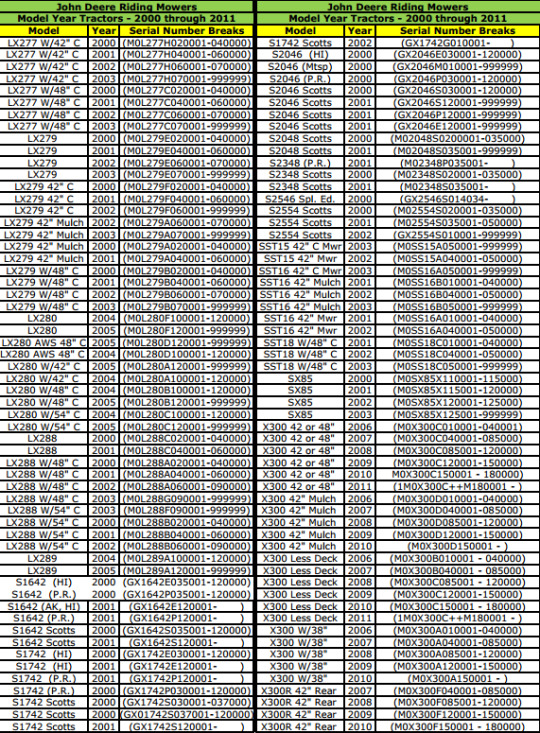
Trane RTU model #SXHEC9040E76AD8D3D01GGNRTX S= Self Contained X= DX cooling,Extended Casing H= Single Zone E= 5th Developement sequence C90= 90 Tons 4= 460/60/3 XL 0= No Heat E= Design Sequence 7= 100% Exhaust w/ statitrac & 15 hp motor 6= Ex fan Drive 600 RPM A= Throw away filters D= Supply Fan HP 40 ( 2-20HP) 8= Supply Fan Drive 800 RPM D= !00% Economizer 3= VAV ( SA temp Control w/ IG Vanes) D= BAYSENS014 O= Standard Ambient Control 1= UL Approval
Trane Tonnage from Model Number
TTP018 = 1-1/2ton
TTP024 = 2 ton
TTP030 = 2 1/2 ton
TTP036 = 3 ton
TTP042 = 3 1/2 ton
TTP048 = 4 ton
Example of Trane Model Identification
The Trane model number is #TWE030C140B0, let’s try to decode this model number:
TW = split component heat pump compatable
E = Electric furnace (like they said, heat strips are added in the field, could be anything from 10kw to 25 kw)
0 = Brazed refrigeration connection
30 = 2.5 ton like you mentioned
C = Major development sequence C is standard system, E would be VS motor, P would be high eff system
1 = 220-230/1/60 (electric rating)
4 = Accurtron flow control check valve
0 = Standard insulation
B = Minor design sequence (means nothing other than to the facotory)
0 = Service digit (they change these as they do “improvements” on thier stuff)
Reading Ruud Model Numbers Explained
Trane model number nomenclature split into several segments. Each segment will have assigned a number of letters and digits. Trane uses their model number to identify its use in the HVAC system.
How to Decode
First letter: The model number starts with 4. This number represents the type of refrigerant the unit uses. 2 stands for R-22 and 4 stands for R410A.
Second letter. T stands for Trane.
The next 3 letter represents the product type. W stands for split heat pump and T stands for split cooling. The third letter equals the product family. Z = leadership – 2 stage, X = leadership, R = replacement/retail, B = basic, A = light commercial.
The fifth number is for unit’s Seasonal Energy Efficiency Ratio. A single number represents the SEER: 0 = 10, 1 = 11, 2 = 12, 3 = 13, 4 = 14, 5 = 15, 6 = 16, 7 = 17, 8 = 18, 9 = 19.
The six letter. Zero indicates the system’s connections are brazed or soldered.
The seven and eight number indicate tonnage. How many BTUs the unit produces in thousands. For example: 36 = 36,000 BTUs.
The nine letter represents the age. Any type of major modifications done to the system since it was originally manufactured explained here. Click here for more information on how to know the age of trane from serial number.
Number ten indicates the power supply voltage. 1 = 200-230/1/60 or 208-230/1/60, 3 = 200-230/3/60, 4 = 460/3/60.
The position eleven, twelve and thirteen. These numbers represent any secondary function.
Position fourteen stands for minor design modifications
The last letter is the unit part’s identifier code.
The Trane Model Identification Number of a product is often featured prominently on the packaging of said product. On the physical product itself, the model number is most commonly found on the front, rear or bottom of the product or in the manual pdf.

See Also
Reading Ruud Model Numbers Chart
As the model number includes some vital information about your Trane HVAC unit. Use our guide above to decode the Trane model number. For more complex problems please contact the professionals HVAC technician. They will help you get the information you need and make sure you get the perfect solution for your whole HVAC system.
How To Read Ruud Furnace Model Numbers
Decoding the Trane model number need patience and accuracy, focus on each segments and you’ll break the code quickly. If you have any issues with finding your model number or determining what it means, don’t hesitate to contact us.

0 notes
Text
Djay Pro 2 Mapping
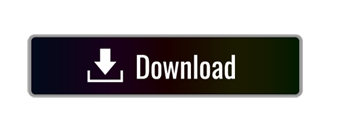
1. djay Pro’s unique, modern interface is built around a sophisticated integration with iTunes and Spotify, giving you instant access to millions of songs.
Djay Pro 2 Mapping Software
Djay Pro 2 Mapping
The LC6000 Prime officially supports Serato DJ Pro, Virtual DJ, and DJay Pro (both laptop and tablet/phone). Given the open nature of Traktor Pro 3, it can likely be MIDI mapped, and I do not doubt that someone will figure out a good mapping template for Traktor. Djay Pro 2 Traktor S2 Mk2 Mapping This is a mapping of the NUMARK DJ2GO2 for Djay Pro:mac/iOS fully matching the native Serato mapping! Please note it's for DJ2GO2 (version 2), it hasn't been tested with DJ2GO (version 1).
2. Pristine sound quality and a powerful set of features including high-definition waveforms, four decks, audio effects, video mixing and hardware integration give you endless creative flexibility to take your sets to new heights.
3. djay Pro 2 is the next generation of Algoriddim’s multiple award-winning DJ software with countless new features, a redesigned user interface, and advanced library management tools.
Since Keyboard Hack is an Android app and cannot be installed on Windows PC or MAC directly, we will show how to install and play Keyboard Hack on PC below: Firstly, download and install an Android emulator to your PC; Download Keyboard Hack APK to your PC. Pc keyboard mac keys. Seil is a straightforward Mac OS X application specially designed to help you change the default function of the Caps Lock key to another key. Quickly remap the CapsLock key using key codes What is. Oct 18, 2020 - Explore Kim Fryars's board 'Computer Hack' on Pinterest. See more ideas about hacking computer, computer shortcuts, mac keyboard shortcuts. Two of the most useful and popular shortcut commands on a keyboard are Ctrl+C (Copy) and Ctrl+V (Paste). For example, if you want to copy some text from a document, first select the text with the mouse and then press Ctrl+C. If you want to paste that text, move your mouse to a new area on the document and press Ctrl+V.
Features and Description
Key Features
Latest Version: 2.0.15
Licence: $49.99
Rated 4.5/5 By 3,491 People
What does djay Pro 2 do? djay Pro 2 is the next generation of Algoriddim’s multiple award-winning DJ software with countless new features, a redesigned user interface, and advanced library management tools. djay Pro’s unique, modern interface is built around a sophisticated integration with iTunes and Spotify, giving you instant access to millions of songs. Pristine sound quality and a powerful set of features including high-definition waveforms, four decks, audio effects, video mixing and hardware integration give you endless creative flexibility to take your sets to new heights. WHAT’S NEW All-new UI • 1-, 2-, 4-deck, and video modes• Modular design with customizable tools, sampler and FX configurations • New high-res waveforms• New Video mode with Photos integration• Single Deck view: prepare your tracks and library• Automix viewLibrary Management • “My Library” section to create your own playlists • Spotify integration • Create smart playlists with tracks from iTunes, Spotify, and the file system• Powerful track filtering: filter any playlist by BPM, key, and other attributes• Split mode: show two library sources side by sideAutomix AI™• Automatic, beat-matched mixes based on artificial intelligence• Queue and Playlist automation• Automatic transitions • Match powered by SpotifyPhotoBeat™• Mix photos in perfect sync with the beat• Beat-matched automatic photo slide shows• Adjustable frequency of photos per beat• Image effects Advanced Features • Keyboard Shortcut Editor • Save up to 8 loops per song • Assign names to saved cue points and loops • Cue Loops New audio engine • High-quality, low-latency audio engine• Post-fader FX• High-quality effects, filter, and EQs• Master output effects via AudioUnitsFEATURES OVERVIEW Spotify Integration• Instant access to millions songs• Playlists, Songs, Charts, Browse• Match: cloud-based song recommendations• Instant access to BPM and Key information through the cloud• On-the-fly playlist editing and song saving• Drag & Drop from Spotify app• Powerful audio streaming technology: ultra-low latency, advanced effects, on-the-fly analysisCDJ Integration - officially certified by Pioneer DJ• Native support for CDJ lineup• Guided plug & play setup• Full hardware control including slip mode, scratching, pitch bending, looping, cueing, master tempo• Library navigation including Spotify, iTunes, waveforms, and cue point display on the CDJ screens• Connect up to 4 CDJsRecording• AAC / WAV• iTunes exportAudio Processing• Advanced time-stretching (up to +- 75%)• Pitch shifting (up to +- 1 octave)• Audio mixing with adjustable crossfader curves• EQ, panning, and highpass/lowpass filtering • Audio Limiter• Support for Audio Unit plug-insAudio Analysis • BPM and beat detection• Flexible beat grids with support for dynamic tempo• Frequency-based colored waveforms• Key detection • Auto-gain / Normalize• Multi-core batch analysisHardware Integration• Native support for over 50 MIDI controllers • Native support for Pioneer DJ CDJ lineup• Advanced MIDI Learn• External Mixer Mode• Support for multi-channel USB audio interfaces• Support for external audio input and microphonesBuilt for macOS• Support for Touch Bar • Native 64-bit application• Optimized for MacBook Pro and iMac with Retina Display• Multi-core analysis (up to 24 processing threads on 12-core Mac Pro)• Extensive keyboard shortcuts• Multi-touch trackpad control• iCloud integration• Accessible via VoiceOverdjay Pro 2 is compatible with any Mac running macOS 10.11 or later.A Spotify Premium subscription and an internet connection is required to access the Spotify music catalog from djay Pro 2. No recording available for songs from Spotify.To use songs from iCloud in djay Pro 2 please download them first via iTunes. DRM protected songs are not supported and djay Pro can not access tracks from Apple Music.
Download for MacOS - server 1 --> $49.99
Download Latest Version
Download and Install djay Pro 2
Download for PC - server 1 --> MAC: Download for MacOS - server 1 --> $49.99 Thank you for visiting our site. Have a nice day!
More apps by algoriddim GmbH
This is a mapping of the NUMARK DJ2GO2 for Djay Pro:mac/iOS fully matching the native Serato mapping !

Please note it's for DJ2GO2 (version 2), it hasn't been tested with DJ2GO (version 1).
It was created by Jay Neural for DJ.MG (DJ Mega Gear).
It's mapped as close as possible to the layout printed on the hardware and as close possible to how it works with Serato.
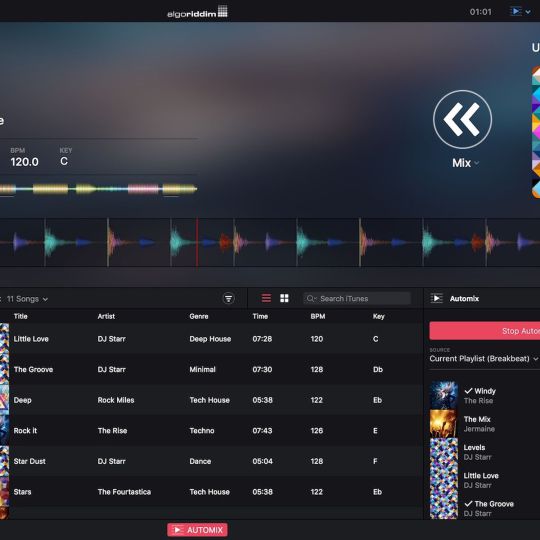
Features :
- Fully mapped to match exact same behaviour as Serato native mapping
- Compatible with iOS
Enable full Djay for iOS compatibility to the DJ2GO2 thanks to this mapping by following these steps :
- Launch iTunes
- Connect your iOS device and let it trust your computer when prompted
- Click on the tiny device icon that appears on the top of iTunes's main section
- Click on 'File Sharing' on the left
Djay Pro 2 Mapping Software
- Find the Djay app on the app's list
- Drag the mapping in the Documents section and wait until it's uploaded
- Disconnect your iPhone and connect your AMX through the USB Camera Kit (preferably USB3 version, otherwise a powered hub will be required)
Ezcap video capture software download mac.
Recommendations :
- I recommend disabling pre-listen auto-select mode before using this mapping (by clicking on the top-left headset icon and unchecking the auto-select box).
- Don't hesitate to post comments requesting fixes or new features. Notice this mapping's intend is to stay as close as possible to the original Serato behavior so if you wish to add other layers (when multiple modifiers will be possible) or add features that are very different from the original mapping, it'll be better to start a new project.
You're using NI Traktor Pro ? Try out our AMX mapping !
Djay Pro 2 Mapping
Enjoy ! Rate and comment if you like this mapping !
For updates, follow @JayNeural and @DJMegaGear on Twitter !
Also subscribe to our Youtube channel on http://youtube.com/djmegagear as we'll be posting videos for our mappings in the near future.

0 notes
Text
Electrical Engineer – Components DMS – Remote
**29915BR****Title:**Electrical Engineer – Components DMS – Remote**Job Description:****Essential Job Functions:** · Capable of supporting production testing; data pack generation, engineering changes; machine, design (rotary and linear) · Strong familiarity with DMS (obsolescence) is a must, where to identify diminishing material supply and assure replacement requirements from new supplier meets design intent. · Capable of Analyzing rotational forces, eddy currents, generator assemblies; thermal analysis · Have an understanding of qualification testing including vibration, shock, thermal, sand and dust, sheer stress, burst, pressure; generation of analytical reports and test reports; data reviews, requirements reviews; support of internal meetings; procurement support (for SRI’s and CAD’s) · Exposure to have Instrumentation and Data Acquisition experience in the areas of Torque, Flow, Temperature, Pressure, Voltage, Current, Load · Experience with total hardware Integration a plus as well as knowledge of hydraulic power and load circuits, Gas control systems · Exposure to High pressure nitrogen and helium systems and Pneumatic systems preferred · Execute analysis tasks and make technical recommendations based on engineering judgment.**Qualifications** · 5+ year experience in Electrical Engineering · BS or higher in Electrical Engineering or equivalent · Exposure to the Aerospace industry is highly preferred · Experience with project management preferred – required to actively manage tasks · Proficiency with MS Office, particularly MS Excel, required**Physical Requirements & Work Environment:**Examples: · Mostly Office Environments.
Occasional Shop Floor involvement · Substantial amounts of telephone and computer work. · Heavily Regulated Industries with strict adherence to procedures. · Flexibility to meet business deadlines by staying late or arriving early. · Typical 8 hour days plus lunch / 40 hour weeks / core (required) hours are 9 AM to 4 PM · Ability to use personal transportation to visit customer locations. · Due to the nature of the work, all candidates must be a U.S.
Citizen or Permanent Resident.The physical demands described here are representative of those that must be met by an employee to successfully perform the essential functions of this job.
Reasonable accommodations may be made to enable individuals with disabilities to perform the essential functions.**Location: Vergennes, VT****Travel: Up to 10%****Compensation Type: Competitive wages.
Position also qualifies for benefits including medical insurance, dental insurance, disability, life insurance, 401(K), tuition reimbursement, and paid time off.****Status: Full-Time Exempt****Reports to: Team Lead****Contact:** [email protected]**Auto req ID:**29915BR**Job Type:**Full Time-Regular**Assignment Country:**United States**Total Years of Exp:**3 – 6**Education Type:**Bachelor Degree-NonTechncial**Assignment State:**VERMONT**Assignment Location:**Vergennes**Experience Level:**Mid Level
The post Electrical Engineer – Components DMS – Remote first appeared on Remote Careers.
from Remote Careers https://ift.tt/3ojDKnf via IFTTT
0 notes
Text
Senior Sales Executive, Public Sector at Visionary Integration Professionals in Jacksonville, Florida
Apply Now!
https://www.disabledperson.com/jobs/36075227-senior-sales-executive-public-sector
Visionary Integration Professionals (VIP) is an industry-leading provider of tech-enabled services, IT managed services, and management consulting services. VIP helps its clients strengthen mission outcomes by combining deep industry specialization, agility to adapt as needed, and an unwavering commitment to client satisfaction. VIP brings expertise in how to deploy systems that align people, processes, and technology to accelerate strategic change and to deliver business results in partnership with its clients. Since 1996, VIP has worked with over 1,200 state and local, federal, and commercial clients. To learn more about VIP, please visit: www.trustvip.com
The Public Sector Business Unit for VIP is growing exponentially. In response, VIP is looking forward to hiring a Senior Sales Executive to further expand across the U.S. The Senior Sales Executive is responsible for creating and executing a strategy to sell tech-enabled services, IT-managed services, and management consulting services to the public sector. VIP has had great success working with a diverse group of industry-leading software providers including Salesforce, Accela, Infor, Mark43, Tyler, OpenText, Okta, Socrata and SAP. This Public Sector Senior Sales Executive will lead or be involved with the full sales cycle including sales strategy, lead generation, high-level solution assessment, partnering/teaming, proposal leadership, account plan management, and deal closure.
This is a remote position on the East Coast.
Responsibilities include:
Develop and execute a strategic sales plan for assigned target market to achieve quarterly and annual sales quota set forth by the company
Constantly cultivate relationships with prospective and existing customers, supplement demand generation activities with personal rolodex and prospect contacts
Secure and attend meetings with prospective customers to gain information pertaining to their business needs and current environment, develop sales messaging and conduct client presentations to C-level executives, qualify opportunities
Shape the future project scope for prospective clients, establish optimal company solutions and corresponding cost estimates
Select the best of breed partners with the best-fit solutions to tailor how VIP responds to RFPs, secure new business, and most effectively deliver to clients' business needs
Lead the proposal process in conjunction with the proposal team to ensure compelling and compliant bids are submitted
Represent VIP at trade shows and events
Actively manage prospects, opportunities, and territory pipeline leveraging SFDC CRM
Stay current with new product knowledge, technology, services, and industry developments
Maintain and communicate plans and reports regarding sales activities on a regular basis
Requirements:
Minimum 5 - 8 years of industry experience or technology sales to government entities (i.e. federal, state and local)
Experience with complex BPO/ITO/System Integration solution sales cycles with diverse product offerings required
Proven and verifiable success managing, meeting and surpassing an $5 to $10 million annual quota
Proven remote sales and demand creation capability, proven ability to conduct discovery/needs analysis with prospective customers and to develop a successful action plan
Excellent interpersonal and customer service skills in both written and verbal communications, poised in communicating with customers, partners, consultants, and internal team members
Proven formal presentation skills before large and small groups
Proven negotiating and influencing skills
Demonstrated ability to "set the right expectations" for prospective customers
Excellent analytical and problem-solving skills
Proven self-starter in addition to a team player
Demonstrated proficiency in Outlook, Word, Excel, PowerPoint, and Salesforce
Proven track record of exceeding quarterly and yearly sales goals
Ability to travel to customer sites, company meetings and out-of-town events as required
Bachelor's degree or equivalent experience required
Please note this job description is not designed to cover or contain a comprehensive listing of activities, duties or responsibilities that are required for this job. Duties, responsibilities and activities may change at any time with or without notice.
0 notes